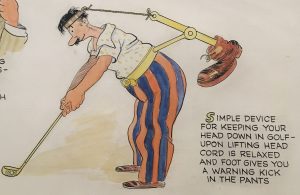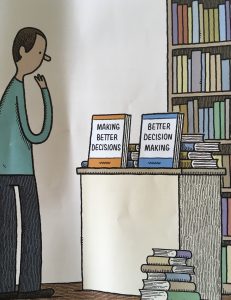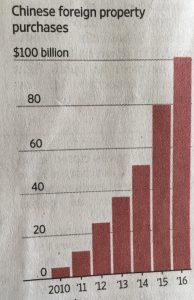News 2018
December 2018:
Mapping the Brain’s Genetic Landscape
Scientists have taken a step toward building a computer model of the brain’s genome, one that may help clarify the genetic roots of schizophrenia, autism and other disorders.
“For the past two decades, scientists have been exploring the genetics of schizophrenia, autism and other brain disorders, looking for a path toward causation. If the biological roots of such ailments could be identified, treatments might follow, or at least tests that could reveal a person’s risk level.
In the 1990s, researchers focused on genes that might possibly be responsible for mental distress, but then hit a wall. Choosing so-called candidate genes up front proved to be fruitless. In the 2000s, using new techniques to sample the entire genome, scientists hit many walls: Hundreds of common gene variants seemed to contribute some risk, but no subset stood out.
Even considered together, all of those potential contributing genes — some 360 have been identified for schizophrenia — offered nothing close to a test for added risk. The inherited predisposition was real; but the intricate mechanisms by which all those genes somehow led to symptoms such as psychosis or mania were a complete mystery.
Now, using more advanced tools, brain scientists have begun to fill out the picture. In a series of 11 papers, published in Science and related journals, a consortium of researchers has produced the most richly detailed model of the brain’s genetic landscape to date, one that incorporates not only genes but also gene regulators, cellular data and developmental information across the human life span.
A research team led by Nenad Sestan, another brain scientist at Yale, analyzed cells from tissue samples from 16 locations in the brains of dozens of people of all ages. The brains were collected post-mortem, and about half were from people who had been diagnosed with a disorder. The 16 brain regions correspond to areas, such as the prefrontal cortex, thought to be affected by problems like schizophrenia or bipolar disorder.
The team tracked changes in the activity of genes and other molecular processes in those cells, looking for patterns that correlated with schizophrenia, bipolar disorder or autism. It identified a network of genes active in specific cell types — genes that were apparently communicating with one another — at about the stage in life when disorders begin to surface. Working backward, the researchers could trace the network pattern to specific cell types, biological activity and timing, as if reconstructing the how and when of a crime scene.
“Having this insight will help us establish some potential causes and what they mean for neuropsychiatric disorders, and create new, testable hypotheses,” Dr. Sestan said.
The result from all this work is a computer model for brain genomics that scientists can search — a database akin to Google Earth that charts specific genetic addresses in the brain and reveals which genetic and biological processes are active there, and at what point during maturation.
Dr. Matthew State, chair of the department of psychiatry at the University of California, San Francisco, and a co-author on two of the papers, said: “Essentially what these papers do is lay out cellular and molecular landscape at a resolution that’s never existed before. I see it as foundational work, and an investment that will pay off in giving us a far richer context to develop new hypotheses and study these disorders.”
NY Times

The horror of genetically modified babies
The biggest ethical concerns for now are with rogue scientists enticing couples who do not realize the risks to babies that might result from the experiments.
“A Chinese scientist recently claimed he had produced the world’s first gene-edited babies, setting off a global firestorm. If true — the scientist has not yet published data that would confirm it — his actions would be a sensational breach of international scientific conventions. Although gene editing holds promise to potentially correct dangerous disease-causing mutations and treat some medical conditions, there are many safety and ethical concerns about editing human embryos.
Here are answers to some of the numerous questions swirling around this development.
What happened?
The scientist, He Jiankui, said he used Crispr, a gene-editing technique, to alter a gene in human embryos — and then implanted the embryos in the womb of a woman, who gave birth to twin girls in November.
That is illegal in many countries, including the United States. China has halted Dr. He’s research and is investigating whether he broke any laws there. Among the concerns are whether the couples involved in Dr. He’s research were adequately informed about the embryo editing and the potential risks involved.
Dr. He says he has submitted his research to a scientific journal. But nothing has been published yet, and he announced the births of the twins before his research could be peer-reviewed by fellow scientists. He also appears to have taken other secretive steps that defy scientific standards.
What is Dr. He’s background?
Dr. He, 34, first worked with the Crispr gene-editing technology while obtaining a doctorate in biophysics from Rice University in Houston. He did postdoctoral research at Stanford and returned to his native China in 2012 under a program designed to draw Western-trained Chinese researchers back home. There, he founded two genetic-testing companies, and became affiliated with the Southern University of Science and Technology in Shenzhen.
He presented early phases of his Crispr research to American scientists at conferences in the United States, but disclosed to very few people that he was planning to actually create pregnancies by implanting edited embryos in women.
Why are scientists up in arms?
Changing the genes in an embryo means changing genes in every cell. If the method succeeds, the baby will have alterations that will be inherited by all of the child’s progeny. And that, scientists agree, is a serious undertaking that must be done with great deliberation and only to treat a serious disease for which there are no other options — if it is to be done at all.
More worrying, Crispr often inadvertently alters genes other than the one being targeted, and there are also circumstances, called mosaicism, where some cells contain the edited gene and others do not. Dr. He claimed in a video that Crispr did not affect other genes in the twins and that the babies were “born normally and healthy,” but there is no way to know if that is true.
What are the potential implications?
Many scientists are concerned that Dr. He’s experiment could have a chilling effect on support for legitimate and valuable gene-editing research.
“Should such epic scientific misadventures proceed, a technology with enormous promise for prevention and treatment of disease will be overshadowed by justifiable public outrage, fear, and disgust,” said Dr. Francis Collins, director of the National Institutes of Health.
What are the safeguards against this?
In the United States, Congress has barred the Food and Drug Administration from even considering clinical trials involving human embryo editing. The National Institutes of Health is prohibited from funding such research. The National Academies of Science, Engineering, and Medicine issued a report in 2017 concluding that editing the genes of human embryos should only be acceptable in the narrowest of circumstances. It would have to be used to correct a serious genetic disorder that causes disease or disability; there would have to be no other alternatives; there would have to be good evidence that the benefits would outweigh the risks; and there would have to be a plan in place to follow the gene-edited children.
What are the ethical concerns?
Some worry that this is the first step toward using gene editing to create people with extreme intelligence, beauty or athletic ability. But that, for now, is not possible. Such traits are thought to be affected by possibly hundreds of genes acting in concert, and affected in turn by the environment.
The biggest ethical concerns for now are with rogue scientists enticing couples who do not realize the risks to babies that might result from the experiments. And when those children grow up, the altered genes will be passed on to their children, and to their children’s children, for generations to come.” NY Times

An Ancient Corner of Italy Finds the World on Its Doorstep
The southern region of Basilicata, its people poor and its food and history rich, has been named Europe’s Capital of Culture for 2019.
“A mayor really isn’t supposed to say something like this.
“We don’t want tourists.”
I waited for the punch line. None came.
“We don’t want to be occupied by tourists,” he continued.
Tourism, he explained, will deplete a city of its soul — and this city has a prehistoric soul.
I was in Matera, an ancient city of about 60,000 people, perched on top of Italy’s high heel. Mayor Raffaello De Ruggieri and I sat under a pergola of young vines, a spotty veil of shade beneath the Mediterranean’s punishing sun. In 2019, Matera — the jewel of the southern Italian region of Basilicata — will be anointed the European Capital of Culture. It is a source of great honor and pride for the town. All year long, there will be festivals and exhibitions. Thousands upon thousands of, well, tourists will descend on the city.
“This city has been alive for 8,000 years,” he told me. “But it has always been poor.”
Mr. De Ruggieri then began to review those last 8,000 years. And as he did, three dates in Basilicata’s recent history appeared over and over: Nineteen-thirty-two, when Basilicata was renamed Lucania by the Fascists (it reverted back to Basilicata in 1948). Nineteen-forty-five, when the dissident doctor and writer Carlo Levi published his memoir of exile here, Christ Stopped at Ebola, which became a definitive document of the realities of Southern Italy — extreme poverty, famine, disease, widespread malaria. Finally, 1993, and redemption, when the United Nations Educational, Scientific and Cultural Organization, or Unesco, added Matera to one of the most exclusive lists in the world.
Mr. De Ruggieri eyes crinkled with pride at the last development. “We went from shame to being a World Heritage site,” he said.
We were on the patio at the Sextantio Le Grotte Della Civita Hotel having coffee and overlooking a ravine — a steep, rocky valley leading down to a gurgling riverbed and the dark, ancient, caves of Parco Nazionale Alta Murgig. Around us, the city told its own history: crude stone walls, stairs worn by armies of time, and, most extraordinarily, Paleolithic caves, once home to families and farm animals, carved into the matrix of the town. Some of them had recently, symbolically, been repurposed into luxury hotels and cafes. It was a striking dichotomy: A view that will transport you to the ancient past and a caffè macchiato that will bring you right back to the five-star present.
We arrived at the Tavole Palatine, 6th century B.C. Greek ruins dedicated to Hera in the town of Metaponto by early afternoon. Imagine long rows of connected limestone columns framed by bushes of oleander — pink and white flowers that are fragrant, delicate and deadly. No one was there, not a soul. It felt more like being in the backyard of an eccentric billionaire with a green thumb than an ancient temple to the Greek goddess of marriage.
Just inland from the ruins is the town of Bernalda, and Francis Ford Coppola’s hotel, Palazzo Margherita. Chances are, if you have ever heard of a hotel in Basilicata, it is this one — a 19th-century palazzo Mr. Coppola converted into a nine-room luxury hotel in 2004.
“Every 10 kilometers, it changes, Basilicata,” said Rossella De Filippo, the hotel’s manager. “Different skyline, different colors, different everything. This is what makes Basilicata special.” NY Times

Chinese hackers intensify their focus on America’s commercial & industrial sector
“The nature of China’s espionage has also changed. The hackers of the People’s Liberation Army — whose famed Unit 61398 tore through American companies until its operations from a base in Shanghai were exposed in 2013- were forced to stand down, some of them indicted by the United States. But now, the officials and analysts say, they have begun to be replaced by stealthier operatives in the country’s intelligence agencies.
The new operatives have intensified their focus on America’s commercial and industrial prowess, and on technologies that the Chinese believe can give them a military advantage.
Why the espionage has spiked again is a matter of debate. Some officials and analysts call it a cause of the worsening trade relationships, others a symptom. Still others argued that the tightening of American export controls in critical industries like aerospace and rules on Chinese investment in Silicon Valley — which China sees as part of a “containment” strategy to blunt its industrial and geopolitical rise — has led the Chinese once again to try to steal what they cannot buy.
The impetus for the 2015 accord was one of the most blatant espionage operations ever conducted by the Chinese government: the removal, over a period of more than a year, of 22 million security-clearance files on American officials, military personnel, contractors and American intelligence officers.” NY Times

November 2018:
Elderly volunteer in La Jolla, San Diego
An elderly volunteer who was in his eighties was cleaning the scenic trail in La Jolla during Thanksgiving holiday. A very special “Thank You” to this anonymous, respectful, selfless and hardworking person in his 80s who volunteered to help in cleaning the environment and nature.



UK Employers Implanting Workers with Microchips
Companies in the United Kingdom are increasingly implants their employees with microchips. They embed the microchips in the hands of employees that can track their behaviors.
The privacy activists expressed their deep concern about this process that is a violation of the individual privacy.
Other social activists protesting what they call the violation of human dignity. The last decade many pets, dogs and cats were implanted with microchips by their owners to know their exact whereabouts and in case they are lost: now English employers are doing the same with their employees.
Christian groups also condemned this act and called it “Mark of the Beast” citing the Book of Revelation.
The English company, Bioteq is distributing and implanting microchips that are made in China and Japan.
According to the researchers, some rats in the laboratory that were implemented with the microchips have showed the signs of cancer. So many academics too joined the opponents of implanting microchips for health and safety reasons.

It’s Good to Be Bad If You’re a Bank
“All else equal, would you rather hire an evil investment bank to underwrite your stock offering, or a good investment bank? I think there are good arguments both ways. An evil investment bank might do evil things to you, which you won’t like. On the other hand, it might do evil things to investors on your behalf, which you might like; if there is evil in the world, you might as well hire it so it’s on your side. Also an evil investment bank might hang out with all the evil investors, who have a lot of money and will buy your stock, while a good investment bank will only hang out with good investors, who have less money.
Or whatever, I don’t know, it’s a model. More generally, if your model is “the whole financial system is evil,” then evil investment banks should be preferable and more successful, because they will be better plugged in to the (evil) networks of the financial system.
Here’s a fun paper from Thomas Roulet of Cambridge’s Judge Business School, whose model really is kind of “the whole financial system is evil”; as the school’s blog summarizes it:
The study concludes that negative coverage actually helped banks gain IPO business from corporate customers, as those corporates view certain banking practices widely criticised after the financial crisis (such as appetite for risk, short-termism and big bonuses) as consistent with industry norms, thus suggesting quality of service.
“This study shows how divergence in audiences’ perception of typical industry behaviours can make wrongdoing beneficial,” says the paper authored by Dr Thomas Roulet, University Senior Lecturer in Organisation Theory at Cambridge Judge Business School. “Most audiences tend to disapprove of wrongdoings, but specific stakeholders may interpret this disapproval as an indication of the focal organisation’s level of adherence to professional norms.”
The model is roughly that “professional norms,” in business, are evil, and so businesses looking to hire qualified professional investment banks tend to look for the ones who are most evil. And so winning IPO mandates is correlated with negative press coverage. What kind of negative press coverage? These delightfully specific kinds:
The media coverage was evaluated based on a list of 204 words built on a qualitative analysis of a sample of opinion articles. The articles were then coded on the basis of how those words were associated with the banks. The words were grouped into four factors that have been heavily criticised since the financial crisis:
Greed: words such as “obscene”, “excess”, “selfish”, and “shameless”.
Violence as in a battleground: “assault”, “frenzy”, “vicious”, “fierce”.
Opacity as in fostering secrecy: “covert”, “cryptic”, “dubious”, “hazy”.
Risk-taking behaviours: “casino,” “tempt”, “daring”, and “gamble”.
“This study suggests that the coverage of misconduct can actually act as a positive signal providing banks with incentives to engage in what is broadly perceived as professional misconduct.” It is broadly perceived as professional misconduct, but it is narrowly perceived—within the profession, and its target audience of businesses—as proper professional conduct.
Obviously you can tell this story without using the word “evil,” and I am joking at least a little bit when I use it. The work of finance is esoteric, and its norms are specific and contextual; in many cases, those norms look bad to outsiders but are sensible and useful in their context. Trading ahead of a client order for a foreign-exchange fixing can be perfectly appropriate hedging, but looks like bad bad front-running when it is exposed as an FX scandal. Taking large risky positions in derivatives can be a perfectly appropriate way to facilitate clients’ hedges, but looks like bad scary prop trading when it loses money. Pricing and allocating an IPO so it is likely to trade up probably serves the goals of banks and investors and issuers, even though outside commentators regularly describe it as “leaving money on the table” for issuers. Sophisticated clients tend to understand what banks are doing and why, and not to take the criticisms too seriously, although I still find it a bit counterintuitive that they’d think more criticisms would be good.
I used to work at Goldman Sachs Group Inc., including during a period when it was heavily criticized for being, um, “a great vampire squid wrapped around the face of humanity, relentlessly jamming its blood funnel into anything that smells like money.” We did fine. There was a distinct sense that clients thought we were evil but smart, and that they’d rather have us on their side than against them. Also I would sometimes go pitch oil companies, and they would welcome us warmly and thank us for being so widely hated, because it made them look good by comparison. I suppose this is evidence for the “the whole financial system is evil” view.
Speaking of Goldman, here is a story about how its stock fell yesterday on bad news about its involvement in the 1MDB scandal, where it collected $600 million in fees for underwriting bonds whose proceeds were mostly stolen and used to pay bribes. Arguably if you are looking for an investment bank to underwrite a vast scheme of corruption and theft, you should pick the one with the least negative press coverage (better cover!), but again there are good arguments on both sides.” Bloomberg

The key to the long life
In 2013, Google cofounder and CEO Larry Page announced the formation of a new Alphabet entity dedicated to solving the pesky puzzle of mortality. Since then, the billion-dollar longevity lab known as Calico—short for California Life Company—has been trying to tease apart the fundamental biology of aging in the hopes of one day defeating death. The hyper-secretive research venture has released few details about what it actually does inside its Silicon Valley lab, but there have been hints. One of the company’s first hires was renowned geneticist Cynthia Kenyon, a UC San Francisco researcher who 20 years ago doubled the lifespan of a lab roundworm by flipping a single letter in its DNA.
Shortly after joining Calico, Kenyon recruited a UCSF bioinformatics postdoc named Graham Ruby. He didn’t want to dig into worm genetics or study the company’s colony of long-lived naked mole rats. He wanted to first ask a much broader question: how big a role do genes play, anyway, in determining how long someone lives? Other scientists had tried to ask that question before, with conflicting results. To clear things up would require getting much, much more data. So Calico went to the biggest family history database in the world: the consumer genetics and genealogy firm Ancestry.
In 2015, the companies inked a research partnership to investigate the human heredity of lifespan, with Ruby leading the charge to sift through Ancestry’s vast forest of family trees. What he found by analyzing the pedigrees of more than 400 million people who lived and died in Europe and America going back to 1800 was that although longevity tends to run in families, your DNA has far less influence on how long you live than previously thought. The results, published Tuesday in the journal Genetics, is the first research to be made public from the collaboration, which ended quietly in July and whose terms remain confidential.
“The true heritability of human longevity for that cohort is likely no more than seven percent,” says Ruby. Previous estimates for how much genes explain variations in lifespan have ranged from around 15 to 30 percent. So what did Ruby uncover that previous studies had missed? Just how often amorous humans go against the old adage that “opposites attract.”
It turns out that through every generation, people are much more likely to select mates with similar lifespans than random chance would predict. The phenomenon, called “assortative mating,” could be based on genetics, or sociocultural traits, or both. For example, you might choose a partner who also has curly hair, and if the curly-haired trait winds up being somehow associated with long lifespans, this would inflate estimates of lifespan heritability passed on to your kids. Same thing for non-genetic traits like wealth, education, and access to good health care. People tend to choose partners in their same income bracket with the same terminal degree, both of which are associated with living longer, healthier lives.
The first hint that something other than genetics or a shared family environment might be at work came when Ruby tried looking at in-law relatives. His analysis started with a set of family trees comprising 400 million individuals. The data had been cleaned, de-identified, and stitched together by genealogists and computer scientists at Ancestry based on subscriber-generated public information. Using the basic laws of heredity—everyone inherits half their DNA from one parent and half from the other, repeated across generations—Ruby’s team looked at how related two people were and how long they lived. They investigated parent-child pairs, sibling pairs, various cousins, and so on. Nothing much surprising popped out there.
But when Ruby looked at in-laws, things started to get weird. Logic suggests you shouldn’t share significant chunks of DNA with your siblings’ spouse—say your brother’s wife or your sister’s husband. But in Ruby’s analysis, people connected through a close relative’s marriage were almost as likely to have similar lifespans as people connected through blood. “I sort of kick myself for being surprised by this,” says Ruby. “Even though no one has shown the impact of assortative mating to such an extent before, it aligns well with how we know human societies are structured.”
Wired

The DIRTY Legacy of China’s and India’s Growth
“But the price of that progress is suffocatingly deadly—bad water and filthy air.
The sixth-biggest cause of death globally is small-particle pollution, chemical specks that enter the lungs and can contribute to cardiovascular diseases, lung cancer, and infections. It led to more than 4 million deaths in 2016. Ninety-nine percent of children 5 years old and younger in South and East Asia breathe unhealthy air. Much of China’s particulate pollution comes from industrial facilities, especially coal-burning power plants. In India, PM2.5 comes not only from cars and coal-fired power stations, but also from widely used domestic cookstoves and the common agricultural practice of burning to clear fields. Masks and respirators are common in Asia’s choking cities, but few can filter out all the particles and noxious gases hanging in the air. There are herbal medicines that purport to clean the lungs, as well as food, cosmetics, and beverages that claim to counter the effects of pollution. Keeping windows closed and running an air conditioner have been shown to cut the influx of dirty air indoors by half. But people with a personal or family history of disease may be better off leaving town—at least during times of high pollution.” Bloomberg

Doctors can soon prescribe visits to Montreal Museum of Fine Arts
“In the 21st century, culture will be what physical activity was for health in the 20th century,” said MMFA director general Nathalie Bondil.
Art heals.
That’s the philosophy behind a new initiative from the Montreal Museum of Fine Arts, which will allow doctors to soon be able to prescribe a visit to a museum.
“There’s more and more scientific proof that art therapy is good for your physical health,” said Dr. Hélène Boyer, vice-president of Médecins francophones du Canada and the head of the family medicine group at the CLSC St-Louis-du-Parc. “It increases our level of cortisol and our level of serotonin. We secrete hormones when we visit a museum and these hormones are responsible for our well-being. People tend to think this is only good for mental-health issues. That it’s for people who’re depressed or who have psychological problems. But that’s not the case. It’s good for patients with diabetes, for patients in palliative care, for people with chronic illness. Since the ’80s we’ve been prescribing exercise for our patients because we know exercise increases exactly the same hormones. But when I have patients who’re over 80, it’s not obvious that I can prescribe exercise for them.”
The Montreal Museum of Fine Arts announced Thursday that as of Nov. 1, physicians who are members of Médecins francophones du Canada will be able to send patients on visits to the MMFA, allowing patients, accompanied by caregivers or family members, to enjoy the health benefits of a free trip to see some art.
The museum says the one-year pilot project is the first such initiative in the world.
It will be used to deal with a wide variety of physical and mental-health problems.
Thomas Bastien, director of education and wellness at the Museum of Fine Arts, notes that the museum has been working with the medical community for 20 years to try to use art to help their patients. But this will be the first time that the doctors will be able to make museum prescriptions.
“We saw that the museum was good for people, so we decided to start this program with the doctors,” said Bastien. “If you’re suffering from breast cancer, you could come to the museum and you might feel better.”
Doctors will each be able to assign up to 50 museum prescriptions over the course of the pilot project. Each prescription will allow entry for up to two adults and two children age 17 or under.
There are some anglophone doctors, who work in English and French, who are members of Médecins francophones du Canada.”
Montreal Gazette

October 2018:
Big Data Reveals Heavy Multitaskers Have Reduced Memory
“The smartphones that are now ubiquitous were just gaining popularity when Anthony Wagner became interested in the research of his Stanford colleague, Clifford Nass, on the effects of media multitasking and attention. Though Wagner, a professor of psychology at Stanford University and director of the Stanford Memory Laboratory, wasn’t convinced by the early data, he recommended some cognitive tests for Nass to use in subsequent experiments. More than 11 years later, Wagner was intrigued enough to write a review on past research findings, published in Proceedings of the National Academy of Sciences, and contribute some of his own.
The paper, co-authored with neuroscientist Melina Uncapher of the University of California, San Francisco, summarizes a decade’s worth of research on the relationship between media multitasking and various domains of cognition, including working memory and attention. In doing that analysis, Wagner noticed a trend emerging in the literature: People who frequently use many types of media at once, or heavy media multitaskers, performed significantly worse on simple memory tasks.
Wagner spoke with Stanford Report to explain the findings from his review on media multitasking and cognition, and discuss why it’s premature to determine the impact of these results.
How did you become interested in researching media multitasking and memory?
I was brought into a collaboration with Cliff Nass, a Stanford faculty member in communication who passed away a few years ago, and his master’s student, Eyal Ophir. They had this question: With the explosion of media technologies that has resulted in there being multiple simultaneous channels available that we can switch between, how might this relate to human cognition? Eyal and Cliff would come chat with me about their early findings and – I have to say – I thought it was complete hooey. I was skeptical. But, after a few experiments, the data were increasingly pointing to a link between media multitasking and attention. Their findings struck me as potentially important given the way we’re living as humans in this attention economy. Years later, as a memory scientist my interests continued to grow. Given that attention and cognitive control are so fundamental for memory, I wanted to see if there was a relationship between media multitasking and memory.
Heavy media multitaskers have many media channels open at once and they switch between them. A heavy media multitasker might be writing an academic paper on their laptop, occasionally checking the Stanford basketball game on TV, responding to texts and Facebook messages, then getting back to writing – but then an email pops up and they check it. A light media multitasker would only be writing the academic paper or may only switch between a couple of media. They may turn off Wi-Fi, put away their phone or change their settings so they only get notified every hour. Those are some extreme examples, but they provide a sense of how people differ in their media use. Moreover, because our media landscape has continued to accelerate and change, those who are considered a heavy or light media multitasker today may not be the same as those a decade ago.
In the review we noticed an interesting potential emerging story. One possibility is that reduced working memory occurs in heavy media multitaskers because they have a higher probability of experiencing lapses of attention. When demands are low, they underperform. But, when the task demands are high, such as when the working memory tasks are harder, there’s no difference between the heavy and light media multitaskers. This observation, combined with the negative relationship between multitasking and performance on sustained attention tasks, prompted us to start looking at intrasubject variability and moment-to-moment fluctuations in a person’s ability to use task goals to direct attention in a sustained manner.”
Neuroscience Journal

Myths about Apple
“Apple CEO Tim Cook is fond of reminding us that the company is unlike some other tech giants — think Google and Facebook — because its main business is selling hardware, not pelting consumers with targeted advertising based on information it’s collected about them. “We could make a ton of money if we monetized our customer — if our customer was our product,” he told Recode’s Kara Swisher and MSNBC’s Chris Hayes in an interview in March . “We’ve elected not to do that.” As UBS analyst Steven Milunovich has said, “Monetizing hardware has its advantages in creating trust.” It’s true that Apple has opted out of the ad business and doesn’t snoop on users of its products; it even makes it tougher for other companies to do so (the Safari browser was the first to block third-party cookies by default). But a recent Goldman Sachs report estimated that Google will pay Apple $12 billion next year to remain the default search engine on the iPhone, iPad and Mac. Let’s be clear: The only reason Google would be willing to fork over a sum anywhere in that range is because targeting Apple fans with ads is so profitable. Apple is making a tremendous amount of money from the tracking of its customers’ search results; it has merely rented the right to scrutinize users to a third party.
It is true that Macs are less malware-ridden than their Windows counterparts. But partly that’s because Apple ships only 7 percent of the world’s computers, making it a far less juicy target for bad guys. Still, the software company Malwarebytes reported a 270 percent increase in Mac-specific viruses from 2016 to 2017. And a fixation on viruses neglects the modern era’s biggest threats. Social-engineering attacks — which attempt to fool you into making mistakes such as handing over credit card details, passwords or corporate secrets — are surging. Owning an Apple offers no protection. Other assaults don’t require access to your computer at all: Almost 150 million U.S. consumers had personal information, including Social Security numbers, leaked in last year’s Equifax breach, which occurred when the credit-reporting agency failed to patch its servers. When it comes to security, increasingly we’re all in the same leaky boat — Mac and Windows users alike.” Washington Post

The Results of Your Genetic Test Can Change
“The results of a genetic test may seem final — after all, a gene mutation is present or it is not. That mutation increases the risk of a disease, or it does not.
In fact, those findings are not as straightforward as they might seem, and the consequences may have grave implications for patients.
While a person’s genome doesn’t change, the research linking particular bits of DNA to disease is very much in flux. Geneticists and testing labs constantly receive new information that leads them to reassess genetic mutations.
As a result, a mutation seen as benign today may be found dangerous tomorrow. And vice versa. But there is no good way to get the new information to doctors and patients.
The result: The gene test you had a few years ago might yield a startlingly different result now.
The problem affects a minority of patients, mostly people with unusual mutations. The more common disease-causing mutations — like those that predispose you to breast or colon cancer — are so well studied that their meaning is not in doubt.
In a recent study, researchers at Myriad Genetics, a diagnostic company, reviewed data on 1.45 million patients who had genetic tests from 2006 to 2016 to see if the results originally reported still held true.
The lab issued new reports for nearly 60,000 of them, meaning the old results had been superseded by new data.
But many patients who carry mutations that have been reclassified remain in the dark. “The system is completely chaotic,” said Dr. Sharon E. Plon, a clinical geneticist at Baylor College of Medicine.
There is no systematic way, she said, to tell patients and doctors that a mutation once thought harmless has been shown to be a health hazard or one thought dangerous is actually benign.”NY Times

Study Provides Insights On the Effects of Exercise on Cognitive Performance
“Electroencephalography readings were taken as 24 participants performed a visual working memory task while at rest and during exercise involving different postures: seated on or pedalling a stationary bicycle, as well as standing or walking on a treadmill. (Visual working memory is the ability to maintain visual information to serve the needs of ongoing tasks.)
The investigators found that both aerobic exercise and upright posture improved visual working memory compared with passive and seated conditions. Their analyses also suggest where the neural origins of these observed effects take place.
Our findings hold implications not only for the field of cognitive psychology, wherein our knowledge has been primarily derived from seated, resting participants, but also for our understanding of cognitive performance at large. Although modern society has evolved to become more and more sedentary, our brains may nevertheless perform best while our bodies are active,” said lead author Dr. Thomas Töllner, of Ludwig-Maximilians-University Munich.”
Neuroscience Magazine

Nobel Prize in Physics Awarded to Scientists Who Put Light to Work
“The 2018 Nobel Prize in Physics was awarded on Tuesday to Arthur Ashkin of the United States, Gérard Mourou of France and Donna Strickland of Canada for harnessing one of the most ineffable aspects of nature, pure light, into a mighty microscopic force. Dr. Strickland, a self-described “laser jock,” is only the third woman to win the physics prize, for work she did as a graduate student with Dr. Mourou.
Dr. Ashkin will receive half of the monetary prize, worth about $1 million; Dr. Mourou and Dr. Strickland will split the remainder.
The Nobel committee recognized the scientists for their work in transforming laser light into miniature tools. Dr. Ashkin invented “optical tweezers,” which use the pressure from a highly focused laser beam to manipulate microscopic objects, including living organisms such as viruses and bacteria.
Dr. Strickland and Dr. Mourou developed a method of generating high-intensity, ultrashort laser pulses, known as chirped pulse amplification. The work has had a wide range of real-world applications, enabling manufacturers to drill tiny, precise holes and allowing for the invention of Lasik eye surgery.
Some physicists think that chirped pulse amplification eventually will be employed to accelerate subatomic particles, replacing giant contraptions such as the Large Hadron Collider with tabletop experiments. In the physics of tomorrow, “bigger is not necessarily better,” said Robbert Dijkgraaf, director of the Institute for Advanced Study in Princeton, N.J.
In a telephone news conference, Dr. Strickland expressed hope that chirped pulse amplification might one day be used to cure cancer. Dr. Ashkin’s optical tweezers have been especially important in biological research on viruses and other microbes.” NY Times

September 2018:
Chinese fueling instability in Africa
“Over the past five years, China’s official arms sales to Africa have increased by 55 percent and its share of the African arms market has doubled to 17 percent, surpassing the United States, according to the Stockholm International Peace Research Institute. There is also growing evidence that Djibouti is emerging as a strategic transit node for illegal weapons smuggled between Yemen and places such as Somalia.
“The Chinese government has a long history of fueling instability in Africa by trading in weapons with rogue regimes. China sent massive amounts of weapons to the Mugabe regime in Zimbabwe in 2008 while it was under a European Union arms embargo. Beijing long supplied arms to Sudanese dictator Omar al-Bashir that contributed to genocide in South Sudan.
What’s new is that, under President Xi Jinping, Beijing now has the power, influence and intention to combine its economic, diplomatic and military interference in Africa to wide-ranging effect.
“China’s strategy on the continent is a comprehensive one, including economic, political and security elements,” said Joshua Eisenman, assistant professor at the Lyndon B. Johnson School of Public Affairs at the University of Texas at Austin. “For years we’ve looked primarily at the economic side, but now, as China’s relations with Djibouti demonstrate, the political and security elements have become an increasingly important part of China’s relations with African states.” Washington Post

The dangers of eating raw fish
“Raw fish, such as sushi, and other uncooked seafood may be dangerous — even life-threatening — if prepared inexpertly.
Case in point: A 71-year old man in South Korea developed an infection after eating raw seafood, and resulting complications required an amputation of his forearm, according to a report published last month in the New England Journal of Medicine.
The man had a history of Type 2 diabetes and high blood pressure, and he was undergoing dialysis for end-stage renal (kidney) disease. The illness developed within 12 hours of his meal and led to fever and excruciating pain in his left hand.
After two days of suffering, he visited the emergency room at Chonbuk National University Hospital in Jeonju, South Korea.
By the time he reached the hospital, a blood-filled cavity measuring 3.5 by 4.5 centimeters (about 1.5 by 2 inches) had developed on the palm of his left hand, while on the top of his hand and forearm, there was a swelling cavity under the skin.
When his doctors performed urgent surgery, they isolated Vibrio vulnificus, a bacterium commonly found in coastal ocean water, as the cause of his infection.
Vibrio vulnificus
The US Centers for Disease Control and Prevention estimates that these bacteria cause 205 infections each year nationwide. Some cases require amputations, and 15% to 30% of cases are fatal, according to the agency.
After surgery, the man received two powerful antibiotics intravenously. However, the drugs did not keep his skin lesions from worsening, and doctors performed an amputation of his left forearm 25 days after his arrival at the ER.
“The patient did well after the surgery and was discharged home,” the authors of his case report concluded.
Vibrio vulnificus — sometimes incorrectly referred to as “flesh-eating bacteria” — is one of a family of 12 bacterial species that cause sickness in humans. Symptoms of these infections can include watery diarrhea, abdominal cramping, nausea, vomiting, fever and chills. Generally, these infections do not require treatment, and severe illness is rare, according to the CDC.
About 80% of infections happen between May and October, when coastal waters are warmest, and mostly they result from eating infected shellfish, with oysters a common culprit. Still, you can also become infected if bacteria in the water enter an open wound or cut, the CDC says.
Although the South Korean patient’s amputation certainly ranks among the most hair-raising possibilities that can occur after you eat raw fish, other dangers lurk in raw or poorly cooked meals, as well.
Parasites
The growing popularity of sushi and other raw or undercooked fish and seafood dishes in Western countries has led to an increase in illness caused by anisakid nematodes (worms), according to a study published last year in BMJ Case Reports.
Anisakiasis results from eating fish or seafood contaminated with that parasite.
When the worms invade the stomach wall or intestines, the result is gastrointestinal pain, nausea and vomiting, according to the CDC. Some people develop complications, including digestive bleeding, bowel obstruction and peritonitis (an inflammation of the inner wall of the abdomen). Other people may experience an allergic reaction, including swelling, skin rash or even anaphylaxis, which can cause difficulty breathing and loss of consciousness.” CNN

Air pollution is making us dumber, study shows
“Air pollution could be more damaging to our health than previously thought, according to a new study, which found that prolonged exposure to dirty air has a significant impact on our cognitive abilities, especially in older people.
According to the study published Tuesday in the Proceedings of the National Academy of Sciences, breathing polluted air causes a “steep reduction in verbal and math tests scores.”
Researchers at the International Food Policy Research Institute (IFPRI) examined data from the national China Family Panel Studies longitudinal survey, mapping the cognitive test scores of nearly 32,000 people between 2010 and 2014 against their exposure to short and long-term air pollution.
Researchers found that both verbal and math scores “decreased with increasing cumulative air pollution exposure,” with the decline in verbal scores being particularly pronounced among older, less educated men.
“The damage air pollution has on aging brains likely imposes substantial health and economic cost, considering that cognitive functioning is critical for the elderly to both running daily errands and making high-stakes economic decisions,” study author said. Cognitive decline or impairment, which could be caused by air pollution according to the study, are also potential risk factors in developing Alzheimer’s disease or other forms of dementia.
While the study adds to the already numerous health concerns regarding air pollution, it will be of particular concern to developing nations, whose smoggy cities could be hampering national economic development.
“The damage on cognitive ability by air pollution also likely impedes the development of human capital. Therefore, a narrow focus on the negative effect on health may underestimate the total cost of air pollution. Our findings on the damaging effect of air pollution on cognition imply that the indirect effect of pollution on social welfare could be much larger than previously thought.”
According to the World Health Organization (WHO), nine out of every 10 people on the planet breathe air containing a high level of pollutants, with the worst affected regions being Africa and Asia. Of the world’s top 20 most polluted cities, as measured by the WHO, all are in developing countries. Almost all cities in low to middle-income countries with more than a million residents fail to meet minimum WHO guidelines. City dwellers aren’t the only ones breathing in smog either, a study in January found that 75% of deaths related to air pollution in India were in rural areas. While some countries, including China, are taking measures to address air pollution, this will also potentially effect economic growth.
Meanwhile, the wealthiest city dwellers are able to buy their way out of smog.
In Beijing, the rich are specially designing their homes and buying appliances to filter out pollutants in their air and water, while poorer residents are stuck breathing in the unfiltered smog, affecting not only their health but also, according to the new study, their cognitive abilities.” CNN

August 2018:
Brain Networks Responsible for Naming Objects Identified
“Scientists at The University of Texas Health Science Center at Houston (UTHealth) have identified the brain networks that allow you to think of an object name and then verbalize that thought. The study appeared in the July issue of BRAIN. It represents a significant advance in the understanding of how the brain connects meaning to words and will help the planning of brain surgeries.
Their discovery could help explain why people with neurodegenerative disease often forget the names of objects. An estimated 5.7 million Americans of all ages have Alzheimer’s dementia. Described as the tip-of-the-tongue phenomenon in healthy individuals, the inability to recall the name of items is a condition called anomia.
Object naming has been a core method of study of anomia, but the processes that occur when we come up with these names, generally in less than a second, are not well understood. We mapped the brain regions responsible for naming objects with millimeter precision and studied their behavior at the millisecond scale,” said Nitin Tandon, M.D., the study’s senior author and a professor in the Vivian L. Smith Department of Neurosurgery at McGovern Medical School at UTHealth.
“The role of the basal temporal lobe in semantic processes has been underappreciated. Surgeons could use this information to design better approaches for epilepsy and tumor surgery, and to reduce the cognitive side effects of these surgical procedures,” said Tandon, who is also the director of the epilepsy program with the Memorial Hermann Mischer Neuroscience Institute-Texas Medical Center and a member of the faculty at The University of Texas MD Anderson Cancer Center UTHealth Graduate School of Biomedical Sciences.Tandon added that this study is of particular value as it produced convergent maps with three powerful techniques: electrophysiology, imaging and brain stimulation.” Neuroscience Journal

Jurors give $289 million to a man they say got cancer from Monsanto’s Roundup weedkiller
“San Francisco jurors just ruled that that Roundup, the most popular weedkiller in the world, gave a former school groundskeeper terminal cancer.So they awarded him $289 million in damages — mostly to punish the agricultural company Monsanto. Dewayne Johnson’s victory Friday could set a massive precedent for thousands of other cases claiming Monsato’s famous herbicide causes non-Hodgkin’s lymphoma.
Johnson’s case was the first to go to trial because doctors said he was near death. And in California, dying plaintiffs can be granted expedited trials.CNN reported last year that more than 800 patients were suing Monsanto, claiming Roundup gave them cancer.
Since then, hundreds more plaintiffs — including cancer patients, their spouses or their estates — have also sued Monsanto, making similar claims.After three days of deliberations this week, the jury at the Superior Court of California in San Francisco awarded Johnson $250 million in punitive damages and about $39 million in compensatory damages.
It won’t change the fact that Johnson’s two sons might lose their dad soon. But it will help them live more comfortably, Johnson’s attorney Timothy Litzenburg said.Johnson, 46, applied Roundup weedkiller 20 to 30 times per year while working as a groundskeeper for a school district near San Francisco, his attorneys said.
He testified that during his work, he had two accidents in which he was soaked with the product. The first accident happened in 2012.Two years later, in 2014, he was diagnosed with non-Hodgkin’s lymphoma.In March 2015, the World Health Organization’s International Agency for Research on Cancer (IARC) said the key ingredient in Roundup, glyphosate, is “probably carcinogenic to humans.”
Litzenburg said Friday’s verdict is historic, especially since Roundup is the most widely used herbicide in the world.
“This is a big victory for human health worldwide,” he said.” CNN


Twitter Stock Drops After User Numbers Decline
“Twitter reported a decline in monthly active users on Friday, another sign of trouble for President Trump’s favored social network, which has struggled in recent months to tackle accusations of political bias and eliminate vast numbers of fake accounts.The company, which had appeared to be undergoing a surprising resurgence, said it generated $711 million in revenue in its most recent quarter. That was 2 percent above the expectations of analysts, and about 24 percent more than the same period a year ago.
But those figures were overshadowed by Twitter’s announcement that its monthly active users had fallen to 335 million in the second quarter, one million fewer than in the previous three-month period.The results drove Twitter’s stock down 12 percent in premarket trading, one day after investors dumped Facebook shares after the company’s disappointing quarterly earnings. Twitter reported a decline in monthly active users on Friday, another sign of trouble for President Trump’s favored social network, which has struggled in recent months to tackle accusations of political bias and eliminate vast numbers of fake accounts.
The company, which had appeared to be undergoing a surprising resurgence, said it generated $711 million in revenue in its most recent quarter. That was 2 percent above the expectations of analysts, and about 24 percent more than the same period a year ago.But those figures were overshadowed by Twitter’s announcement that its monthly active users had fallen to 335 million in the second quarter, one million fewer than in the previous three-month period.
The results drove Twitter’s stock down 12 percent in premarket trading, one day after investors dumped Facebook shares after the company’s disappointing quarterly earnings.” NY Times

July 2018:
Recent studies call into question the existence of the billion dollar vitamins industry
TAKING MULTIVITAMINS IS USELESS WHEN IT COMES TO HEART HEALTH, STUDY SUGGESTS
Stop Wasting Money on Vitamin Supplements
“Eat a healthy diet for a healthy heart and a long, healthy life.” Said Dr. Eduardo Sanchez, the American Heart Association’s chief medical officer for prevention.
“Multivitamins are often marketed as a shortcut to better health. But the evidence calling their purported benefits into question is pilling up, with the latest research indicating they do nothing to protect our hearts.
Following an analysis of 18 existing studies, researchers concluded taking multivitamins and minerals provided no benefits to preventing heart attacks, strokes or deaths caused by cardiovascular disease.Multivitamins and minerals were defined by the authors as dietary supplements containing greater than three vitamin and mineral ingredients. Products containing herbs, hormones and drugs were not included. Earlier this year, researchers in Canada behind a separate study similarly concluded common supplements such as vitamin D, calcium and vitamin C don’t protect against cardiovascular disease or premature death. That followed a 2013 paper entitled “Enough Is Enough: Stop Wasting Money on Vitamin and Mineral Supplements” in which researchers warned the pills not only have no benefit, and could in fact do harm. These studies call into question the existence of the billion dollar vitamins industry, which by 2024 is expected to be worth $278 billion.Dr. Joonseok Kim, assistant professor of cardiology in the Department of Medicine at the University of Alabama at Birmingham, told Newsweek: “We found that MVM [multivitamin mineral] supplement use does not prevent cardiovascular disease.”They published their findings in the journal Circulation: Cardiovascular Quality and Outcomes, which is published by the American Heart Association.
Kim commented that despite the growing scientific evidence, it has so far been “exceptionally difficult” to spread the message that multivitamins and minerals don’t prevent heart disease—even among nutritional experts. He explained that while the study indicated multivitamins and mineral supplements taken in moderation didn’t appear to harm cardiovascular health, working with a healthcare provider to create a plan to reduce heart disease risk is much more effective.
“If one does not have a confirmed vitamin deficiency, there is no role for vitamin/mineral supplements in cardiovascular disease prevention,” he said. Instead, those concerned about their cardiovascular health should focus on “something that is proven to improve cardiovascular outcomes, such as fruit and vegetable intake and exercise.” Currently, there are no legal hurdles for the manufacturers of mineral and vitamins supplements to cross before they are sold to the general public, and at least 30 percent of the U.S. population take multivitamins and mineral supplements, the authors noted.
“I hope our paper helps to settle the controversy on MVM supplements and cardiovascular health,” said Kim. “Doctors and researchers now have the evidence to put this question to rest and focus on issues that truly affect cardiovascular health. The vitamins and minerals industry should strive to provide accurate information to the public, and refrain from misleading claims on packaging and ads.”
Dr. Eduardo Sanchez, the American Heart Association’s chief medical officer for prevention and chief of the Association’s Centers for Health Metrics and Evaluation, who was not a part of this study, said in a statement: “Eat a healthy diet for a healthy heart and a long, healthy life.
“There’s just no substitute for a balanced, nutritious diet with more fruits and vegetables that limits excess calories, saturated fat, trans fat, sodium, sugar and dietary cholesterol.”Commenting on the Canadian study published in the Journal of the American College of Cardiology, a qualified dietitian and spokesperson for the Dietetic Association told Newsweek it provided further evidence “that there is no ‘pill’ we can take in lieu of a good diet.” “If you have a healthy balanced diet, you do not need to take vitamin and mineral supplements,” she commented at the time. “However recent guidelines suggest we all may wish to consider vitamin D supplementation, particularly during winter months,” he said, when sunlight is scarce, as the vitamin is synthesized in the body through exposure to the sun.”
Newsweek

The Online Gene Test Finds a Dangerous Mutation. It May Well Be Wrong.
“Third-party analysis of raw DNA is not as rigorous as that done in a certified laboratory. But many consumers don’t understand that their results are not conclusive. Dr. Joshua Clayton, a 29-year-old radiology resident at Baylor University Medical Center in Dallas, wanted to learn about his ancestry. So he sent a sample of his saliva to 23andMe, the genetic testing company.
His report was pretty mundane — no new revelations. But then he sent the profile created by 23andMe to a separate company called Promethease, which promises to do a more in-depth analysis for genetic mutations that cause disease.The news was not good. Dr. Clayton got back a report with a sinister red box at the top saying he had a mutation linked to Lynch syndrome, a frightening genetic disorder that leads to potentially deadly cancers at an early age.
In an interview, Dr. Clayton said he “knew, at least cursorily, that false positives were common with these tests.” But “that didn’t change the frightened feelings or concern, because I certainly couldn’t blow it off.”After two weeks of panic and yet another genetic test at a company with expertise in medical diagnostics, he learned the red box result was wrong. He simply didn’t have the mutation.More Americans are embracing consumer genetic testing, but the Food and Drug Administration limits what major firms like 23andMe or Ancestrydotcom can say about a consumer’s health.
So many people are taking an additional step: uploading all the raw data created by these companies to second companies for additional analysis. But these are not firms certified to provide medical diagnoses, nor are they sophisticated academic centers.Companies like Promethease warn customers not to regard their results as medical diagnoses. Mostly, they are comparing a consumer’s raw data to gene variants reported to be linked to disease.
But it’s not at all clear that consumers understand how uncertain their results may be.There are no systematic studies of how often the direct-to-consumer results and third-party analyses are wrong. In one small study, Ambry Genetics — a lab certified to do medical testing — looked at 49 samples sent in by physicians whose patients had been told that they had disease-causing mutations by third-party interpreters.
Ambry found that 40 percent were wrong. In addition, some genetic variations classified by second companies as threatening actually were benign.This tiny sample doesn’t prove that the false-positive rate is 40 percent. But patients like Dr. Clayton are not uncommon, genetic counselors say. And they are increasingly worried about the flip side: false negatives that reassure consumers who actually should be worried.Dr. Judy Garber, director of the Center for Cancer Genetics and Prevention at the Dana-Farber Cancer Institute in Boston, said one of her patients was told by a consumer testing company she had Li-Fraumeni syndrome, which greatly raises the risk of a number of rare cancers.
Further testing showed that diagnosis was wrong. “It makes you worry about the people who don’t come in,” said Dr. Garber.“People think they are getting the same kind of genetic testing as they would get from a certified clinical laboratory,” said Stephany Tandy-Connor, a genetic counselor at Ambry. “Nothing could be further from the truth.”Even some doctors are misled by the reports, she said.Of course, companies like Ambry have an interest in making sure their business is not usurped by consumer testing firms. But it’s also true that the method used by consumer companies is very different from those used by certified clinical laboratories. Consumer companies method look for changes in tiny segments of genes, rather than examining the entire gene and looking for alterations. That is cheap but not comprehensive.” NY Times

Mapping the Brain with Data Science
“A group of researchers at Purdue University are designing data-driven tools that will help clinicians better understand the progression of neurodegenerative diseases by identifying and tracking changes in the brain.
“We’re not to the point where we’re taking X-rays to see if you have a broken bone in your leg, but we’re at least at the stage where we’re saying, ‘Your gait is very funny,’” said Tom Talavage, professor of electrical and computer engineering and biomedical engineering, and a co-investigator for the project. “We can narrow it down to something wrong with your leg, and we can make inferences about what’s wrong with your leg. We can say, ‘You probably have a broken leg because of how you’re walking.’ That’s what we’re really getting at.”The project is led by Joaquín Goñi, an assistant professor of biomedical engineering who studies the network of neural connections composing the human brain. This network is called the connectome, the focus of an emerging field of study known as brain connectomics. Brain-imaging techniques, such as diffusion weighted imaging and functional magnetic resonance imaging (fMRI), allow neuroscientists to model and examine the connectome to understand communication between different regions of the brain. This helps them see which parts of the brain are functioning normally – and which regions are not – by observing changes over time.
“What we’re really doing is starting to create the means to see symptoms of neurodegenerative diseases; they become physical in the graphical approaches we apply. It’s very visual,” Talavage said.The team is using data from the Human Connectome Project, a collection of data sets from different projects focused on the connectome, to research and develop their method. Goñi and postdoctoral researcher Enrico Amico recently published a paper in Nature Scientific Reports using data from the Human Connectome Project to propose a data-driven method for assessing the connectome. Their work demonstrates that individual connectomes are unique enough to be identifiable – and could potentially be used to better understand the differences between people’s individual connectomes and how this relates to their health.
Their project uses brain-imaging data that shows both “structural” and “functional” connectivity – physical connections between different regions of the brain, and the communication between those regions as a subject performs a given task. Making sense of an individual person’s network of connections and understanding their cognitive health depends on images of brain activity collected during these tasks.“When my brain is performing activities, is it more consistently, uniquely me? Or does the task actually make me look like everybody else?” Talavage said. “The end results indicate that we are more uniquely ourselves even when we’re performing the same task.”Taking these detailed pictures of the connectome can be a challenge for neuroscientists. Often the neuro-images are affected by visual noise, which makes it more difficult to make sense of the data.” Neuroscience Journal

June 2018:
U.S. Faces ‘Unprecedented Threat’ From China on Tech Takeover
“China’s “Thousand Talents” program to tap into its citizens educated or employed in the U.S. is a key part of multi-pronged efforts to transfer, replicate and eventually overtake U.S. military and commercial technology, according to American intelligence officials. The program, begun in 2008, is far from secret. But its unadvertised goal is “to facilitate the legal and illicit transfer of U.S. technology, intellectual property and know-how” to China, according to an unclassified analysis by the National Intelligence Council, the branch of U.S. intelligence that assesses long-term trends.
Another tool to gain access to U.S. technology is “joint ventures, mergers, and acquisitions,” Tony Schinella said. “Tech transfer to China is occurring in part through increased levels in investment and acquisitions of U.S. companies, which hit a record level in 2016 before dropping somewhat in 2017 and again in the first half of 2018.” China’s aggregate investment in American technology over the past decade, from 2007 to 2017, totaled approximately $40 billion and was about $5.3 billion last year, he said.” Bloomberg

Hands off my data!
15 more default privacy settings you should change on your TV, cellphone plan, LinkedIn and more.
Source:
Geoffrey A. Fowler is The Washington Post’s technology columnist based in San Francisco.
“It’s not just Google and Facebook that are spying on you.
Your TV, your cellphone provider and even your LinkedIn account have side hustles in your data. But in many cases, you can opt out — if you know where to look.
I dug into a bunch of popular products and services you might not think of as data vacuums or security risks and found their default privacy settings often aren’t very private. So I collected here some common settings you can change to stop giving away so much. The following links will let you skip ahead to clickable instructions for televisions, LinkedIn, Twitter, Yahoo, cellphone carriers and WiFi routers.
Despite the rhetoric from tech companies, few actually make it easy to be in control of your data. They hide behind confusing menus.Many of these companies collect our data so they can sell ads targeted to our specific behaviors and interests. They claim people prefer these kinds of personalized ads — but much more often I hear people complain that targeted ads are creepy. Silicon Valley is making surveillance the price of using the Internet.
At the very least, companies should be much more upfront about what they’re doing with our data. I couldn’t get straight answers out of many. Others made avoiding tracking or targeted ads so cumbersome. The steps I outline below are small acts of resistance. But I’m hopeful we can send a message that we’re going to judge products on privacy — and the wise companies will learn to use it as a competitive advantage.

TVs
Your TV is watching you. Often, default settings (or screens you probably clicked “agree” to during setup) allow smart TVs, streaming boxes and cable services to track significant amounts of personal information. They know what you’re watching and what apps you use. In 2017, TV maker Vizio even had to pay millions to settle complaints from the Federal Trade Commission and the state of New Jersey for collecting this kind of data with users’ knowledge.Recent smart TVs from Samsung, the best-selling brand, track how you use your TV to target ads that Samsung inserts on menu screens. During setup, the TV encourages you to agree to a bunch of terms of service and conditions that include permission for “Interest-based advertisements.” You can say no then, but if you didn’t realize what was going on — or now you’re just not sure — you’ll have to dig into your TV’s settings to stop the tracking. With your remote, go to Settings, then Support, then Terms & Policy, then Interest Based Advertisements and choose to Disable interactive services. (On older Samsung TVs, you might find this under the Smart Hub menu.) You’ll find similar settings on smart TVs made by LG, Sony and Vizio. Roku streaming boxes as well as Roku-branded TVs made by TCL, Hisense, Insignia and others by default track the channels and apps you watch.To tell Roku to stop, use your remote to find Settings, then Privacy, then Advertising and tap Limit ad tracking.
Cable services also often track the programs you’re watching so they can target ads. For Comcast, the largest cable company, turn off the targeting on the Web, then going to My Account, then finding Alerts and Ad Preferences, then scrolling until you find Cable Targeted Advertising, tapping Edit near it, and then clicking Opt out and then Save. Other cable companies have a similar functions with slightly different names. Spectrum from Charter, whose settings are available at this link, calls it Additional Marketing and Targeted Television Ads. Verizon Fios, whose settings are at this link, calls it Relevant TV advertising.
Here’s my job evaluation for LinkedIn: office busybody. Based on the assumption that you want to broadcast your professional life, the social network’s defaults expose a lot. LinkedIn has some 60 data, privacy and advertising settings you can control. To get to them on your phone’s LinkedIn app, tap your picture in the upper left corner, then the gear icon in the upper right corner. On the Web use this link, or go from your home screen to Me, then Settings. Your profile is visible to the public and searchable on Google. Data shared by default could include your first and last name, your number of connections, your posts on LinkedIn and details of your current and past work experience. Scaling back this information is most easily done on the Web. Go to Settings and then Privacy, then click on Change next to Edit your public profile. There you can turn off your public profile entirely and choose which details you’re comfortable sharing. Every time you look at someone’s LinkedIn profile, LinkedIn tells them you were there. Make your visits anonymous by going on the Web to Settings to Privacy, then tapping Profile viewing options. There, switch to Private mode.Every time you make an edit on your profile, LinkedIn broadcasts the change to your connections. Turn off the oversharing by going to Settings, then Privacy, then click to change Sharing profile edits, and toggle it to No.
Unlike other social networks, most people assume what they do on Twitter is public. So maybe you’re not surprised to know that it’s in the business of selling your attention to advertisers, just like Facebook and LinkedIn. By default, Twitter will try to target ads to you based not only on what you do on Twitter, but also your activity outside the social network, including information it buys from data brokers. Turn that off on the Web by tapping on your profile picture, then Settings and privacy, then Privacy and safety, then scroll down to find and tap Personalization and data, then toggle off everything.Props to Twitter: Its defaults for permission to track your precise location and collect your address book contacts are both set to off.
Yahoo
Yahoo, now part of a company called Oath and owned by Verizon, is still used by millions of people for email, to follow news and explore the Web. And like its rival Google, Yahoo is making money by tracking you and selling your attention to advertisers. The good news is Yahoo keeps most of its settings in one Privacy Dashboard.Yahoo tracks what you do across its sites and services — including the content of your email and messenger communications — to, you guessed it, target ads at you. Turn it off from the Dashboard. Tap Personalized Advertising on our Products, and toggle it to off, or Disagree. Yahoo is tracking your precise location from its apps and websites.Turn it off from the Dashboard. Tap Precise Location, and toggle it off, or Disagree.Yahoo is following you across the Web to provide “personalized experiences” on other sites and — surprise, surprise — deliver more targeted ads. To turn it off from the Dashboard. Tap on Oath Across the Web, and toggle it off, or Disagree.
Phone plans from AT&T, Verizon, T-Mobile and Sprint
Nobody knows more about where you go and what you do than your cellphone provider. And even though you’re already paying them for service, some want to make money off your data, too. Shouldn’t they be the ones paying us for our data?
AT&T by default enrolls customers into what it calls a Relevant Advertising program that uses a broad report of your location (such as your Zip code) and other data to let advertisers target you in websites and apps you see on your phone. AT&T also tries to persuade you to click yes — it had even gotten me — to opt in to a program called Enhanced Relevant Advertising that tailors ads using more detailed information, including your Web browsing, app usage, and precise location.
Turn off both settings, log into your AT&T account and tap your name at the top to bring up a menu, then click View profile, then Communication preferences, then click on Privacy settings. There, make sure both Relevant Advertising and Enhanced Relevant Advertising, are opted out for all your phone numbers.
Verizon’s data programs include a partnership with Oath that makes it easier for them to track you for advertising. It also has a business selling aggregated data from customers that includes the websites we visit, apps we use and the places we go.A Verizon spokesman didn’t answer my questions about the company’s defaults. You can make sure you’re opted out of both programs by using this link, or logging in to your Verizon Wireless account, then going to My Profile, then privacy settings. There find Relevant Mobile Advertising and Business & Marketing Insights, and set both to Don’t use my information.
T-Mobile’s data programs potentially allow advertisers and T-Mobile’s partners to target you based on your location, Web browsing and app activity.A T-Mobile spokeswoman said she wasn’t sure what the company’s default settings were. You can check that you’ve got them all turned off by logging in to your T-Mobile account, then tapping Profile, then Privacy and Notifications. There, turn off Interest-Based Ads, Web Browsing & App Information and Device Location.
Sprint wants to use data about the websites you visit, apps you use and broad location data for its “Mobile Advertising Program” — but participation is turned off by default. Check your settings on the Web by using this link, or logging into your Sprint account, going to All about my account, and then tapping Manage mobile advertising and reporting preferences and making sure Do not use my info is selected. While you’re there, you might also turn off Business and marketing report preferences — on by default — which allows Sprint to sell your anonymized data including precise location information to marketers and researchers. (Sprint says it is one of the few companies that even gives you the option to opt-out of such a program.)
WiFi routers
Here’s a concern that’s as much about security as it is privacy: The default administrator password for your home WiFi router probably is … “password.” That’s a problem because anybody within range could log in and change your settings — or, worse, hack into your devices. Many home routers come with generic passwords that they intend for you to change, even if most people don’t. This isn’t the password you use to get on the WiFi — it’s the control panel that runs your router. The most common is username: admin, password: password. One common way to access your router’s control panel is to join your home network, then type into a Web browser bar 192.168.1.1 If that doesn’t work, try 10.0.0.1. If none of those work, try Googling your router’s brand name and router login. Then log in — try starting with username: admin, password: password. If that doesn’t work, you might have changed your password at some point, so congratulations! Or it is possible your router has an unusual default password, so Google for your brand’s default admin password. Once you’re in, find your way to settings and change your password to something more unique. While you’re there, update your router’s software (called firmware), too, to keep you safer from hackers.”
Amazon
Amazon has grown from a bookstore to an everything store — to the maker of devices that listen and watch what’s happening around the house. (Amazon CEO Jeffrey P. Bezos owns The Washington Post, but I review all tech with the same critical eye.) Amazon keeps a recording of everything you’ve ever said to its talking artificial intelligence gadget Alexa — and also, we’ve learned recently, some things you didn’t intend to say to Alexa. You can listen to what Amazon has recorded by going to the Alexa app, then tapping Settings, then History. There you can delete individual entries. You can delete a whole bunch of recordings at once by logging into your Amazon account on the Web, then looking under Account and Lists settings and finding Manage your content and devices (or, just use this link). Find your Echo or other Alexa device in the list, then click manage voice recordings.Amazon’s settings don’t offer as much as you might want: There’s no setting to stop Alexa from saving recordings in the future. Here’s a fun idea next time you’re at a house party: Go up to an Echo speaker, and order its owner a 10-pound bucket of sea salt. Surprise! Anyone with access to your Echo speaker can order products on Amazon.
In the Alexa app on your phone, under Settings, scroll to Voice Purchasing, and turn it off — or at least put a voice code in place that your kids (or terrible friends) won’t guess. Your Amazon “wish list” is open to the public by default. Yes, it’s nice to buy someone a gift — but I’m doubtful everyone understands their wishes are open to everyone. Set your list to private by clicking on your wish list, then clicking on the three dots next to the share list, then tapping manage list, then changing Privacy to Private. Amazon knows more than Santa about what you’d like for Christmas. It keeps a log of every Amazon product you look at, not just the ones you buy. Stop Amazon from tracking you by clicking Browsing History on Amazon’s homepage and clicking View and Edit (or just use this link), then clicking on Manage history, and turning it Off.
Microsoft
Windows 10 isn’t just an operating system used by 700 million devices: It’s a training school for Microsoft’s less-well-known A.I., Cortana. When you set up Windows 10, it suggests turning on Cortana — which means letting Microsoft collect your location, contacts, voice, speech patterns, search queries, calendar and messaging content.
If you don’t plan to use Cortana, decline it when you first set up your computer. Turning it off after the fact is much more complicated. There’s no single button, and some PCs put settings in different places. On most, you can open Cortana and click on its settings, then click on Permissions & History, and then individually turn off everything. Also turn off what’s listed under Manage the information Cortana can access from this device. Then go to Cortana, click on the Notebook icon, then click on your Microsoft account and log out. That stops Cortana from collecting future data. To delete what it already knows, point your Web browser to your Microsoft Privacy settings page and click view and clear on various types of data it has collected. Also go to the Cortana tab and tap Clear Cortana data.Windows helps advertisers track your PC using an anonymous ID. Go to Settings, then Privacy, then General, and turn off Let apps use advertising ID to make ads more interesting to you based on your app usage.
Apple
Apple still makes accommodations for online ad targeting — and you have to know where to look to stop it. The iPhone shares an anonymous ID for advertisers to target you. To stop it, go to your iPhone’s Settings, then Privacy then Advertising, and switch on Limit Ad Tracking.This will affect Apple-made apps, ads served via Apple’s advertising system and apps that use the iPhone’s Advertising Identifier.
By default, Google’s keeping a list of everything you search for — and every website you visit. Turn that off under Activity controls. Google is the giant black hole of the tech world, sucking up as much personal data as it can get away with. Google is keeping track of every phrase you’ve ever searched for, every site you’ve visited and every YouTube video you’ve watched … including the embarrassing ones. On the Web, turn off Web and App Activity. While you’re there, scroll down and also turn off YouTube Search History and YouTube Watch History. Google makes a map of everywhere you go that would make the CIA envious. On the Web, at the same link for Google’s activity controls to turn off Location History. There are several ways you might have turned on Location History. Google tells me that in the future, it will stop asking you to turn on this function when you initially set up its Assistant an Android phone. (Imagine that: a tech giant actually scaling back some data collection.)While you’re at it, you can stop oversharing with Google’s advertisers. Google helps marketers target you on Google-owned sites such as YouTube and Gmail. On the Web, use this link for Ads Settings to turn off Ads personalization.
Like skinny jeans, Facebook makes you share more than perhaps you ought to. It’s time to take a hard look at what you’re putting out there. (Note: Facebook is rolling out new privacy settings on its mobile apps, but you may have not gotten them yet. They change the location of some controls on your phone but don’t change your choices.) Anyone can see all your Facebook friends and all the weird pages you follow. That includes employers, stalkers, identity thieves and quite possibly your mother.On your phone’s Facebook app, tap the button with three lines, then scroll to Settings & Privacy, then tap Settings and then Privacy Settings. Or use this link on the Web. Then switch Who can see your friends list from Public to Friends — or, even better, Only me. Do the same on that same page with a separate setting for Who can see the people, Pages and lists you follow.I know what you did last summer … because when people tag you in a photo or post, it automatically shows up on your timeline.In the Facebook app under Settings & Privacy, then Settings, then Timeline and Tagging (or at this link on the Web) switch On the option Review posts you’re tagged in before the post appears on your timeline.Your face belongs to Facebook. By default, it scans all the photos and videos you share to create digital face IDs — unless you tell them hands off your mug. In the Facebook app under Settings & Privacy, then Settings, then Face Recognition (or at this link on the Web) switch to No under Do you want Facebook to be able to recognize you in photos and videos?
Turn off these three settings that let Facebook advertisers use even more data to target you. Don’t give it all away to Facebook advertisers, either. Reminder: Each member in North America was worth $82 in advertising to Facebook in 2017. Advertisers can use very personal data to target you, making Facebook ads even creepier than they have to be. In the Facebook app’s Settings & Privacy menu, tap Settings, then Ad Preferences (or use this link on the Web). Then tap open the section called Your information. There, switch Off ads based on your relationship status, employer, job title and education. While you’re in Ad Preferences, head down to Ad settings and switch to Not allowed for Ads based on data from partners and Ads based on your activity on Facebook Company Products that you see elsewhere Surprise, you’re starring in Facebook ads! Did your check not arrive in the mail? Oh right: Just by “liking” a page, you give Facebook advertisers permission to use your name in ads they show your friends — and you don’t get a dime. On your phone under Settings & Privacy, then Settings, then Ad Preferences (or at this link on the Web) tap open Ads Settings and switch to No One the setting for Ads that include your social actions.
On the Internet, the devil’s in the defaultsYou’re not reading all those updated data policies flooding your inbox. You probably haven’t even looked for your privacy settings. And that’s exactly what Facebook, Google and other tech giants are counting on.They tout we’re “in control” of our personal data, but they know most of us won’t change the settings that let them grab it like cash in a game show wind machine. Call it the Rule of Defaults: 95 percent of people are too busy, or too confused, to change a darn thing. Give me 15 minutes, and I can help you join the 5 percent who are actually in control.”
Washington Post

Scientists from five universities say doing one simple thing every day could add years to your life
“Want to prolong your life? Put some pep in your step.
Walking at an average pace was linked to a 20% reduction in the risk of mortality compared with walking at a slow pace, while walking at a brisk or fast pace was associated with a risk reduction of 24%, according to a new study. A similar result was found for risk of dying from cardiovascular disease.
It’s not too late to start. In fact, the benefits were far more dramatic for older walkers. Average pace walkers aged 60 years or over experienced a 46% reduction in risk of death from cardiovascular causes, and fast pace walkers a 53% risk reduction, the study found. The findings appear in a special issue of the Journal of Sports Medicine edited by Emmanuel Stamatakis, a professor of physical activity, lifestyle, and population health at the University of Sydney’s Charles Perkins Centre and School of Public Health.
“A fast pace is generally five to seven kilometers per hour, but it really depends on a walker’s fitness levels,” Stamatakis said in a statement. He has another suggestion to increase your heart rate: “Walk at a pace that makes you slightly out of breath or sweaty when sustained.”The study was a collaboration between the Universities of Sydney, Cambridge, Edinburgh, Limerick and Ulster. The researchers linked mortality records with the results of 11 population-based surveys in England and Scotland between 1994 and 2008 in which participants reported their walking pace.
A recent Harvard university study concluded that you could add 10 years to your life by following five habits: eating a healthy diet, exercising 30 minutes or more a day, maintaining a healthy weight — a body mass index between 18.5 and 24.9 — never smoking and drinking only a moderate amount of alcohol. In that study, the researchers analyzed 34 years of data from approximately 78,000 women and 27 years of data from more than 44,000 men. The authors predicted that women who adopted these five habits would see 14 more years of life, and men would add 12 years.” Market Watch

Chinese aggressively buying houses in the western countries
According to the Wall Street Journal, Chinese increasingly buying houses in the western countries. This has created a flood of capital “washing over cities” in the west and home price bubbles and distortion. They are defying every attempts to stop them. Chinese home buyers causing 40% increase in the house prices in some areas. “The hot pursuit of places to park money abroad by Chinese investors drove above $100 billion in property purchases outside China.” The critics expressing their concerns because it is not just creating house price bubble, but they bring their own culture too.

The World Can’t Afford High-Tech Insulin
“The researchers who pioneered insulin injections for diabetes sufferers in 1922 were dedicated to making the life-saving treatment widely available, and gave away their rights to profit from the discovery. Yet almost a century later, the medicine is still beyond the reach of roughly half of the 100 million people around the world who need it. Governments should be asking why, and doing something to put this right. Insulin is still expensive because the three major producers — Novo Nordisk, Eli Lilly and Sanofi — have been granted patents on the drug as they have incrementally changed it. First they derived the hormone from animals, then from humans, and most recently from recombinant DNA techniques. With each small advance, the price has gone up.
The advanced formulations are meant to work faster or longer, but they’ve been shown to offer little or no advantage over the basic alternatives. Yet they cost nearly six times as much. On average, patients pay less than $8 a vial for human insulin, and $45 a vial for the analogs. Nevertheless, in developed countries, doctors are widely prescribing analog insulin. In the U.K., analog insulin now accounts for three-quarters of the total supply, up from just 11 percent in 2000. A similar shift in the U.S. has tripled the annual insulin bill since 2002, to $15 billion.Unfortunately, many doctors in low- and middle-income countries have done the same. The World Health Organization has declared that the cost of high-tech insulin outweighs its potential benefit, because governments cannot afford enough of it for all the people who need it.
In Iran, where 5 million people have diabetes, buying analogs rather than human insulin costs the government an extra $49 million a year — money that could be used instead to more widely diagnose and treat the disease. (An estimated 35 percent of diabetes cases in Iran remain undiagnosed.) In sub-Saharan Africa, only 40 percent of countries provide insulin of any kind at public hospitals and clinics. Children born with type 1 diabetes in the least developed of these countries have a life expectancy of less than one year. Governments could save money by purchasing only simple human insulin from smaller drug companies, but they have been reluctant to challenge the big three in the face of the companies’ vigorous marketing.” Bloomberg

Low Neighborhood “Walkability” Linked With Childhood Asthma
“Children living in neighborhoods that are not conducive to walking are more likely to develop asthma and to continue to have this condition through later childhood, according to a new study published in the Annals of the American Thoracic Society. In “Associations Between Neighborhood Walkability and Incident and Ongoing Asthma in Children,” researchers from Toronto’s Hospital for Sick Children (SickKids) and the University of Toronto evaluated associations between home neighborhood walkability and both the incidence of asthma and its ongoing occurrence.Although there have been studies of neighborhood walkability and chronic diseases such as diabetes in adults, this large, long-term study is believed to be the first to look at walkability and childhood asthma.
“We found that children living in neighborhoods with low walkability were more likely to develop asthma and to continue to have asthma during later childhood,” said lead author, Dr. Elinor Simons, a pediatric allergist and clinician scientist who now works at the University of Manitoba and Children’s Hospital Research Institute of Manitoba, Canada. “These findings show a relationship between lack of day-to-day physical activity or sedentary lifestyle and development of new and ongoing asthma in Toronto children.”Dr. Simons and colleagues used healthcare data housed in the province of Ontario’s Institute for Clinical Evaluative Sciences (ICES) to follow 326,383 Greater Toronto children born between 1997 and 2003 until ages eight through 15. Asthma diagnoses were based on the time the children’s data were entered in the validated Ontario Asthma Surveillance System (OASIS), which requires two outpatient visits within two consecutive years or any hospitalization for asthma. Children with asthma in OASIS were followed continuously starting at their time of diagnosis and until the end of the study.
A Walkability Index was used to examine whether the neighborhoods in which these children lived were conducive to walking. Neighborhood characteristics that comprised the index included population density, dwelling density, access to retail and services, and street connectivity.The researchers used two statistical models to determine associations between asthma and walkability: associations between walkability and incident asthma were examined using Cox proportional hazards models, while associations between ongoing asthma and walkability in each year were determined with generalized linear mixed models.”
American Thoracic Society Press Release

ePrivacy Regulation:
the new battle of privacy advocates
“ePrivacy Regulation specifically protects the confidentiality of electronic communications. The law was approved by the European Parliament last fall and is under review by the Council of the European Union, a group of government officials representing the 28 member countries. Bloc officials had originally intended for the law to go into effect this month, but Council negotiations have been slowed by internal disagreements. Most of the lobbying is unreasonable and very low regarding facts,” said Jan Philipp Albrecht, a member of the European Parliament from Germany who steered the G.D.P.R. legislation through Parliament. He pointed to industry “campaigns saying, ‘With ePrivacy, the internet is going dark, and independent media, as well as digital growth, will be lost.’”
Industry and consumer advocates are essentially fighting over a contentious issue central to the post-Cambridge Analytica online economy: whether data-driven digital services represent more of a boon to consumers or the kind of surveillance that can threaten democracy. “With one click you can manipulate hundreds of thousands or millions of people, whether you know their names or not,” said Birgit Sippel, a European Parliament member who drafted the ePrivacy legislation. “That is why protecting privacy is becoming more important, especially in the digital environment.” The ePrivacy Regulation will replace and broaden an older European Union directive — which covered traditional telecommunications like voice calls — by also covering digital communications like text messaging and video chat apps. The legislation currently provides only one condition under which a company may use data or metadata about users’ electronic communications: obtaining consumers’ explicit and informed permission to use their information for a specific, agreed-upon purpose. The bill also requires companies to offer people the same communications services whether or not they agree to have their data collected.
“Do you really want that app to use your metadata? Do you really want them to read your content on a dating app?” Ms. Sippel asked. “Consumers need to get back control over what is happening with their lives and their data.” But tech industry groups and their supporters argue that ePrivacy’s consent requirement and other provisions are so onerous that they would hinder innovations like smart cars, which automatically transmit safety information back to the manufacturer. And requiring companies to provide equal communications services to people who opt out of data mining, they say, could cause sites or apps that rely on data-driven advertising to start charging fees or close down.
Tech companies and trade groups have waged a furious, multipronged lobbying campaign to shut down, or at least weaken, the legislation. Cisco, Facebook, Google, IBM, Microsoft, SAP, the American Chamber of Commerce, DigitalEurope and the Interactive Advertising Bureau Europe, a digital advertising industry group, have all lobbied officials at the European Commission about ePrivacy, according to a lobbying database created by Transparency International EU, a nonprofit research group in Brussels. With support from Google, the computer industry group also financed a research study last year saying that ePrivacy’s data restrictions could cut revenue for the online news and online advertising industries, diminishing venture capital funding for cloud computing.” NY Times

May 2018:
GDPR: noyb filed four complaints over “forced consent” against Google, Instagram, WhatsApp and Facebook
“Privacy à la “take it or leave it”? The new General Data Protection Regulation (GDPR) which came into force today at midnight is supposed to give users a free choice, whether they agree to data usage or not. The opposite feeling spread on the screens of many users: Tons of “consent boxes” popped up online or in applications, often combined with a threat, that the service cannot longer be used if users do not consent. One the first day of GDPR noyb has therefore filed four complaints against Google (Android), Facebook, WhatsApp and Instagram over “forced consent”. Overview of the complaints. Very similar complaints were field with four authorities, to enable European coordination. In addition to the four authorities at the residence of the users, the Irish Data Protection Commissioner will probably get involved in the cases too, as the headquarter of the relevant companies is in Ireland in three cases.
GDPR prohibits “bundling” The GDPR prohibits such forced consent and any form of bundling a service with the requirement to consent (see Article 7(4) GDPR). Consequently access to services can no longer depend on whether a user gives consent to the use of data. On this issue a very clear guideline of the European data protection authorities has already been published in November 2017. Separation of necessary & unnecessary data usage. An end of “forced consent” does not mean that companies can no longer use customer data. The GDPR explicitly allows any data processing that is strictly necessary for the service – but using the data additionally for advertisement or to sell it on needs the users’ free opt-in consent. With this complaint we want to ensure that GDPR is implemented in a sane way: Without just moving towards “fishing for consent”. Putting an end to annoying pop-ups. If the complaints of noyb are successful, it will also have a very practical effect: Annoying and obtrusive pop-ups which are used to claim a user’s consent, should in many cases be a thing of the past.”
NOYB website

Coffee Waste Is Now Fetching a 480% Premium Over Coffee Itself
“Aida Batlle grows coffee on her family’s farm in the hills surrounding El Salvador’s Santa Ana Volcano. Like generations before her, she had little use for the skin that encases the beans, so she’d turn it into cheap fertilizer or, more frequently, trash it. Then one day, walking past some husks drying in the sun, a smell hit her, a good smell: hibiscus and other floral aromas. It dawned on her, she says, that some value might be extracted from what she had long considered refuse. So she steeped the husks in hot water and had a taste. “Immediately I started calling customers to try it,” she says. More than a decade later, coffee husk—or, as it’s better known, cascara—is having a moment. Starbucks Corp. recently introduced new drinks in the U.S. and Canada sweetened with cascara syrup, and offers a sugar topping made from the husk. Competitors such as Stumptown Coffee Roasters and Blue Bottle Coffee are adding it to their menus, too, as tea and a carbonated drink. The coffee husk now often fetches a higher price than the bean itself does. Batlle says she gets $7 for a pound of cascara, while the average price for coffee hovers around $1.20, the lowest in about two years, because of an oversupply of arabica beans. Cascara contains little caffeine and has a less assertive taste than coffee. In addition to notes of hibiscus, it can have papaya or green apple flavors depending on how and where it’s cultivated, according to Batlle, who counts Blue Bottle among her customers. (Blue Bottle, owned by Nestlé SA, offers a Cascara Fizz soda as part of its noncoffee options.)Sam Sabori, national quality control and roasting manager for Chicago-based Intelligentsia Coffee, says he often associated cascara with heavier flavors like raisins and port. Recently, however, he says, he tried a more “tropical” variety out of Guatemala that stood out, and now the chain is considering cascara for its menu.Cascara sales are still too small to measure. And while demand is growing right now, for farmers such as Batlle there’s still a risk that this will prove no more than a passing fad. “We don’t want to be buying 500 pounds one year and nothing the next year,” says Sabori. “We want this to be sustainable for everyone involved.” Bloomberg

Smarter Brains Run on Sparsely Connected Neurons
“The more intelligent a person, the fewer connections there are between the neurons in his cerebral cortex. This is the result of a study conducted by neuroscientists working with Dr Erhan Genç and Christoph Fraenz at Ruhr-Universität Bochum; the study was performed using a specific neuroimaging technique that provides insights into the wiring of the brain on a microstructural level. Together with colleagues from the University of New Mexico in Albuquerque, Humboldt University of Berlin and the Lovelace Biomedical and Environmental Research Institute in Albuquerque, the team from the biopsychology research unit in Bochum published their report in the journal Nature Communications on May 15,2018.The researchers analysed the brains of 259 men and women using neurite orientation dispersion and density imaging. This method enabled them to measure the amount of dendrites in the cerebral cortex, i.e. extensions of nerve cells that are used by the cells to communicate with each other. In addition, all participants completed an IQ test. Subsequently, the researchers associated the gathered data with each other and found out: the more intelligent a person, the fewer dendrites there are in their cerebral cortex. Using an independent, publicly accessible database, which had been compiled for the Human Connectome Project, the team confirmed these results in a second sample of around 500 individuals. The new findings provide an explanation of conflicting results gathered in intelligence research to date. For one, it had been previously ascertained that intelligent people tend to have larger brains. “The assumption has been that larger brains contain more neurons and, consequently, possess more computational power,” says Erhan Genç. However, other studies had shown that – despite their comparatively high number of neurons – the brains of intelligent people demonstrated less neuronal activity during an IQ test than the brains of less intelligent individuals.“Intelligent brains possess lean, yet efficient neuronal connections,” concludes Erhan Genç. “Thus, they boast high mental performance at low neuronal activity.”
Neuroscience Journal

Even Privacy Advocates Are Tracking You Online
“The primary purpose of Californians for Consumer Privacy, an advocacy group formed by San Francisco real estate developer Alastair Mactaggart, is to push for a ballot initiative adding restrictions on companies that profit from the collection of personal data. Last week, it gave state officials a petition with over 600,000 signatures, which should be enough to get it in front of voters in November. Its website, CA Privacy dot org, is pretty much what you’d expect. There are creepy fictional videos portraying people’s birth date, physical location, and potentially embarrassing info about their online purchases (hair loss prevention shampoo) and the apps they use (online poker). Below the videos, there’s a motivating message: “It’s your personal information. Take back control!”
There is one surprising aspect, though. Each time someone visits, software gleans what information it can about her, then sends that information to Facebook, including her IP address, what web pages she was on before and after visiting, and so on. At this point, both the visitor and the website have basically lost control of what happens with that information.
There’s nothing particularly unusual going on here. At least 79 percent of websites globally have one or more trackers that collect data on their users’ online behavior, according to a 2017 study by Ghostery, a company that makes ad blockers and privacy software. Over 21 percent have more than 10 trackers. Google trackers run 60 percent of the time any web page loads; Facebook’s run 27 percent of the time. Both companies have trackers running on CAPrivacy.org, because the group put them there. It may be hard to find a clearer testament to how entrenched such tracking has become as the default setting of the entire internet. Californians for Consumer Privacy does disclose the existence of the trackers in its privacy policy, which Mactaggart says he wrote himself. “The irony of criticizing Facebook and Google whilst using their services is not lost on us, but this gets back to our rationale for the initiative: Californians should be able to use these services and be secure that their personal information is not being sold. Right now this is not possible,” it reads. Mactaggart argues that Google and Facebook are monopolies and there’s no real choice for someone looking to run an effective website or online advertising campaign. “We end up with this Faustian bargain,” he said. Websites can exist without partnering with Google and Facebook. But few do—because their tools are really useful. It helps that they’re free and easy to use. The Facebook tracker consists of just nine lines of Javascript code. By installing it, website operators can determine whether people who saw their Facebook ads visited their site, and can target people after they’ve left. At the same time, they let Facebook collect information about their users. The company deploys this data to build the profiles it uses to help other advertisers target web users with specific profiles—and further entrench itself at the center of the internet economy. Facebook pixel, a tool for advertisers and developers, collects information like a user’s IP address, available demographic information, and location data. Then the company sells ads that can be targeted using that data.The inability of websites to resist the temptation of these tools is vital to Facebook’s and Google’s domination of the internet—and a big part of how they’ve gathered so much information about practically every person online. “Everyone is using Google Analytics, and everyone is using the Facebook pixel,”Both Facebook and Google oppose Mactaggart’s ballot measure, although Facebook recently withdrew from a coalition actively pushing for its defeat. Facebook has also been trying to reassure people that it will offer them more control over their data. It says it’s building a tool that would allow users to view which websites send data, then clear that history. But any big changes to the default setting of the internet as Facebook and Google have built it up aren’t going to be easy to come by. “It’s just web architecture,” “Privacy was an afterthought.” Bloomberg

WhatsApp Co-Founder Leaving Facebook Amid User Data Disputes
“When Jan Koum, a founder of the messaging app WhatsApp, sold the service to Facebook in 2014, he explained how deeply he cared about the privacy of communication. Growing up in the Soviet Union during the 1980s — when surveillance was a fact of life — had made him realize the importance of being able to speak freely, he wrote. “Respect for your privacy is coded into our DNA, and we built WhatsApp around the goal of knowing as little about you as possible,” Mr. Koum wrote in a blog post after he had sold WhatsApp to Facebook for $19 billion. “If partnering with Facebook meant that we had to change our values, we wouldn’t have done it.” Now, instead of changing his values, Koum is leaving Facebook. On Monday, Koum, 42, a member of Facebook’s board of directors, said in a post on the social network that “it is time for me to move on.” He did not give a reason for his exit. But according to a company executive, who asked not to be identified because the details of Mr. Koum’s departure were confidential, Koum had grown increasingly concerned about Facebook’s position on user data in recent years. Koum was perturbed by the amount of information that Facebook collected on people and had wanted stronger protections for that data, the person said. Koum had discussed leaving the company since late last year, the person added.
Koum’s exit is the highest-profile departure from Facebook after months of controversy that has roiled the social network. The Silicon Valley company has been under scrutiny for how Russian agents used it to influence voters before the 2016 presidential election and, more recently, for a lack of data protections for its more than 2.2 billion members, a subject that gained attention after revelations that the British political consulting firm Cambridge Analytica had improperly harvested the information of as many as 87 million Facebook users. The controversies have prompted disagreements among top Facebook executives about how to deal with those issues. In March, The New York Times reported that Alex Stamos, Facebook’s chief information security officer, intended to leave the company after an internal dispute over how to handle the threat of Russian influence efforts. Facebook has also reshuffled the top ranks of its Washington office, where lobbying and policy matters are handled. Facebook declined to comment beyond Koum’s post. Koum’s decision was earlier reported by The Washington Post. Facebook’s business depends on getting people to spend time on its sites and allowing advertisers to target users based on their interests. WhatsApp has had no advertising on its service, but in recent years it has been sharing more information about its users with Facebook. In March, Brian Acton, who co-founded WhatsApp with Koum and who has since left the company, wrote on Twitter that it was time to delete Facebook after the Cambridge Analytica revelations.” NY Times

Mercury Rising:
Are All the Fish We Eat Toxic?
“The amount of mercury extracted from the sea by industrial fishing has grown steadily since the 1950s, potentially increasing mercury exposure among the populations of several coastal and island nations to levels that are unsafe for foetal development.These are the findings of a study carried out by researchers from Université de Montréal’s Department of Biological Sciences and published this week in Scientific Reports.The study combined data on the amount of mercury fished out of oceans and seas from 1950 to 2014 and the weekly consumption of fish and seafood by the populations of 175 countries between 1961 and 2011. By comparing this data, which was published by the Food and Agriculture Organization of the United Nations (FAO), postdoctoral fellow Raphaël Lavoie was able to estimate these populations’ per capita intake of methylmercury (MeHg), a highly toxic form of mercury. Working under the direction of Professor Marc Amyot, Lavoie estimated that the people of 38 per cent (66 of 175) of the countries examined by the study might be exposed to methylmercury levels higher than the maximum deemed safe for foetal development. The highest-risk countries include the Maldives, Iceland, Malaysia, Lithuania, Japan, Barbados and South Korea. When humans ingest excessively high levels of methylmercury, the toxin’s molecules can penetrate the blood-brain barrier and impact cerebral development, especially in children and foetuses. Industrialization has released vast quantities of mercury into the atmosphere, which have settled in oceans and waterways. This mercury is absorbed by sea creatures, many of which are consumed by humans. Since 1950, demand for seafood has skyrocketed while technological breakthroughs have enabled more intensive forms of industrial fishing. Since the 1990s, when overfishing drastically reduced stocks, industrial fishing has gradually migrated to deep-sea and international waters.The global marine catch totals 80 million tonnes of fish per year, which means that we are also pulling out increasingly large amounts of mercury,” said Amyot.Of the industrial fishing areas listed by the FAO, the Northwest Pacific currently exports the most fish – and the most methylmercury. The Western Central Pacific holds second place, while the Indian Ocean ranks third.
“Together, these three fishing areas exported 60 per cent of the mercury resulting from global seafood production in 2014,” said Lavoie.The people in these regions are some of the world’s top seafood consumers. Species high up on the food chain contain the highest concentrations of mercury. From 1950 to 2014, large fish represented approximately 60 per cent of the global catch (by weight) and nearly 90 per cent of the mercury ingested by consumers from fish.To be safe for foetal development, the threshold for methylmercury consumption is 1.6 micrograms for each kilogram of a person’s body weight per week (1.6 μg/kg/week).By comparing FAO data on global seafood consumption, we observed that from 2001 to 2011 the populations of 38 per cent of the 175 countries we analyzed would have been exposed to weekly doses of methylmercury far above the maximum safe level of consumption for foetal development,” said Lavoie. “Many of these populations are in coastal and island nations, especially developing countries.”
For instance, during that 10-year period, people in the Maldives would have consumed an average of 23 micrograms of methylmercury per kilogram of body weight each week, or more than 14 times what’s deemed safe. The next highest-ranking were people in Kiribati (8 μg/kg/week), Iceland (7.5 μg/kg/week), Malaysia and Samoa (6.4 μg/kg/week), French Polynesia (5 μg/kg/week), Lithuania, Japan and Barbados (4.8 μg/kg/week) and South Korea (4.7 μg/kg/week). By contrast, the global average for mercury exposure over the same 2001-2011 period was estimated at 1.7 μg/kg/week. In Canada, exposure totalled 1 μg/kg/week. Lavoie and Amyot said their estimates are conservative. The global catch by the fishing industry, including artisanal and illegal fishing, is probably 50 per cent higher than the FAO data indicates, they said.
Both researchers believe these estimates could help authorities find ways to reduce the risk of mercury exposure, especially among high-risk populations such as children and pregnant women.Some methods of preparing and consuming fish seem to reduce the risk of methylmercury contamination, they pointed out. In a recent study, they found that cooking fish or consuming it in combination with certain polyphenols contained in foodstuffs like tea could reduce the bioavailability of methylmercury in the human body. Which is good news, because contrary to prevailing opinion, the methylmercury we consume may not be fully absorbed.” Neuroscience Journal

Thousands of Lives Would Be Saved if countries met ATS Clean Air Standards
May 1, 2018─Thousands of lives would be saved each year, and many more serious illnesses avoided, if U.S. counties met standards set by the American Thoracic Society for the two most important air pollutants, according to a new report by the ATS and the Marron Institute of Urban Management at New York University. The ATS’s standards for ozone (O3) and fine particulate matter (PM2.5) are more protective than those adopted by the U.S. Environmental Protection Agency. If the ATS’s standards were met, each year in the U.S. approximately:
•6,270 lives would be saved,
•15,300 instances of serious illness would be avoided and
•7 million missed school and work days would be eliminated.
The ATS Report: estimated excess morbidity and mortality, associated with air pollution above ATS- Recommended Standards is published in the May 1st issue of the annals of the American Thoracic Society. The new report builds on the two organizations’ 2016 “Health of the Air Report” by using the latest air quality data available. The latest report includes two new measures–short-term PM2.5 and lung cancer incidence–to give a clearer picture of how air pollution impacts health in the U.S.The ATS-recommended standards for O3 and PM2.5 are based on scores of national and international epidemiological, animal and human-exposure studies. These standards are more rigorous than National Ambient Air Quality Standards (NAAQS) for both O3 and PM2.5 that the EPA relies upon.
The ATS recommends:
•A 0.060 parts per million (ppm) 8-hour standard for O3, rather than the EPA’s 0.070 ppm standard. Eighty-two percent of monitored counties failed to meet this ATS standard.
•An 11 micrograms per cubic meter (µg/m3) annual standard for PM2.5, rather than the EPA’s 12 µg/m3. Eight percent of monitored counties failed to meet this ATS standard.
•A 25 µg/m3 short-term (24 hours) standard for PM2.5 rather than the EPA’s 35 µg/m3. Twenty-one percent of monitored counties failed to meet this ATS standard.
“In addition to highlighting the benefits of strengthening the NAAQS, this report can help guide local and regional air quality management decisions,” said report co-author Gary Ewart, MHS, chief of the ATS advocacy and government relations program. “The report’s local health estimates can help public officials make difficult decisions regarding how aggressively to adopt new technologies or, alternatively, how aggressively to restrict high-polluting sources.” Lead report author Kevin Cromar, PhD, director of the Air Quality Program at the Marron Institute and associate professor of population health and environmental medicine at the NYU School of Medicine, added, “Metropolitan areas and states with large populations and elevated concentrations of one or both air pollutants would realize the biggest improvements in public health by meeting the more protective standards.”
American Thoracic Society press release

April 2018:
Culture Shapes the Brain: How Reading Changes the Way We Think
“Comparing illiterate individuals and adult readers highlights repeatedly just how much learning to read changes our brains. According to a study by French and Spanish researchers, people who are unable or barely able to read not only find analysing sequences of letters more difficult – they have similar difficulty processing sequences of images. A further study in Portugal found that illiterate persons also find it harder to distinguish how an object is oriented in space – for example, a hammer depicted diagonally, where the head and handle can point in various directions. Practiced readers can only guess at the disadvantages faced by those who have never had the chance to learn to read and write. One area to which little attention has been paid is the cognitive tests used by doctors to diagnose early stage dementia in the elderly. Greek researcher Mary H. Komidis points out that these tests are designed for people who are literate. The abilities they test are often trained by reading and writing, and results from these tests are likely to be skewed accordingly when employed on individuals who are illiterate. In Europe, there are still numerous older people in particular who are unable to read and write. According to UNESCO data, globally the number of people who are illiterate remains at 15 percent. José Morais from the University of Brussels sets out how it is not only the illiterate themselves who are impacted by this, but humanity as a whole. He argues that the effects of literacy do not end when children have learnt to read, but that it has profound and lasting effects on their cognition and knowledge. The ability to read and write is essential to the ability to analyse complex problems and for the flow of ideas and critical thinking. It facilitates informed public debate and sensible collective decision-making. The more literate people are, the better they are able to exercise control over public affairs and contribute to genuinely democratic government.” Neuroscience Journal

A.I. Researchers Are Making More Than $1 Million, Even at a Nonprofit
“Salaries for top A.I. researchers have skyrocketed because there are not many people who understand the technology and thousands of companies want to work with it. Element AI, an independent lab in Canada, estimates that 22,000 people worldwide have the skills needed to do serious A.I. research — about double from a year ago. “There is a mountain of demand and a trickle of supply,” said Chris Nicholson, the chief executive and founder of Skymind, a start-up working on A.I. That raises significant issues for universities and governments. They also need A.I. expertise, both to teach the next generation of researchers and to put these technologies into practice in everything from the military to drug discovery. But they could never match the salaries being paid in the private sector. In 2015, Elon Musk, the chief executive of the electric-car maker Tesla, and other well-known figures in the tech industry created OpenAI and moved it into offices just north of Silicon Valley in San Francisco. They recruited several researchers with experience at Google and Facebook, two of the companies leading an industrywide push into artificial intelligence. In addition to salaries and signing bonuses, the internet giants typically compensate employees with sizable stock options — something that OpenAI does not do. But it has a recruiting message that appeals to idealists: It will share much of its work with the outside world, and it will consciously avoid creating technology that could be a danger to people. “I turned down offers for multiple times the dollar amount I accepted at OpenAI,” Mr. Sutskever said. “Others did the same.” He said he expected salaries at OpenAI to increase as the organization pursued its “mission of ensuring powerful A.I. benefits all of humanity.” OpenAI spent about $11 million in its first year, with more than $7 million going to salaries and other employee benefits. It employed 52 people in 2016.
The amount of money was borderline crazy,” Wojciech Zaremba, a researcher who joined OpenAI after internships at Google and Facebook, told Wired. While he would not reveal exact numbers, Mr. Zaremba said big tech companies were offering him two or three times what he believed his real market value was. At DeepMind, a London A.I. lab now owned by Google, costs for 400 employees totaled $138 million in 2016, according to the company’s annual financial filings in Britain. That translates to $345,000 per employee, including researchers and other staff. Researchers like Sutskever specialize in what are called neural networks, complex algorithms that learn tasks by analyzing vast amounts of data. They are used in everything from digital assistants in smartphones to self-driving cars. Some researchers may command higher pay because their names carry weight across the A.I. community and they can help recruit other researchers. Sutskever was part of a three-researcher team at the University of Toronto that created key so-called computer vision technology. Goodfellow invented a technique that allows machines to create fake digital photos that are nearly indistinguishable from the real thing. “When you hire a star, you are not just hiring a star,” Nicholson of the start-up Skymind said. “You are hiring everyone they attract. And you are paying for all the publicity they will attract.”” NY Times

Scientists Want to Replace Pesticides With Bacteria
“In humans, a healthy microbiome—the universe of bacteria, fungi, and viruses that lives inside all of us—is increasingly recognized as critical to overall health. The same is true of the plant world, and Indigo is among the dozen or so agricultural technology startups trying to take advantage of the growing scientific consensus. Their work is enabled by advances in machine learning and a steep reduction in the cost of genetic sequencing, used by companies to determine which microbes are present. Approaches vary: AgBiome LLC, with funding from the Bill & Melinda Gates Foundation, is studying how microbes can help control sweet potato weevils in Africa, while Ginkgo Bioworks Inc. announced a $100 million joint venture with Bayer AG to explore how microbes can encourage plants to produce their own nitrogen.
Indigo is the best-funded of the bunch, having raised more than $400 million. To develop its microbial cocktails, Indigo agronomists comb through normal fields in dry conditions to see which plants seem healthier than average. They take samples of the thriving plants and “fingerprint” their microbiomes using genetic sequencing; once they’ve done this with thousands of samples, they use statistical methods to pick out which microbes occur most often in the healthiest plants. These proceed to testing, then large-scale field trials. They want to reshape the structure of the agriculture industry completely, competing not only with chemical companies such as Monsanto and Dow Chemical, but also with agricultural distributors like Cargill and Archer Daniels Midland. Perry, a biochemist who grew up on a small farm in rural Arkansas, founded two pharma-related companies, a drugmaker he eventually sold for multiple billions of dollars and an online marketplace for research supplies that went public in 1999. After joining Indigo in 2015, Perry quickly zeroed in on a fundamental business challenge: Most farmers have no choice but to sell their harvest at commodity prices. Without the opportunity to earn more for using environmentally sustainable methods, they have little incentive to alter their ways.One of the biggest challenges the company will face is persuading farmers to turn their back on comfortable relationships with Big Ag. “Farmers have tended to buy seed from the guy their dad bought from, and sold it to the same grain elevator,” Dean says. “This is going to make waves, and not everyone will be happy about it.”
Bloomberg

After Cambridge Analytica, Privacy Experts Get to Say ‘I Told You So’
“For many developers, this is the right time to push ahead with testing more privacy solutions, including more advanced advertising blockers; peer-to-peer browsers that decentralize the internet; new encryption techniques; and data unions that let users pool their data and sell it themselves. Others want to treat tech giants more as information fiduciaries, which have a legal responsibility to protect user data.And for the first time, many privacy experts think internet users will be more willing to put up with a little more inconvenience in return for a lot more privacy.“This is the first blink of awakening of the world to a danger that’s been present for a long time, which is that we are exposed,” Mr. Searls said. “Cambridge Analytica is old, old news to privacy folks.” John Scott-Railton, who researches digital rights and privacy at the Citizen Lab at the University of Toronto, said he recently thought back to all the PowerPoint presentations and papers he had given and seen that cautioned about how third parties might access and abuse user data.
“It didn’t stick until now,” he said. “Now it’s changed, or at least people nod along when we talk about it.” Some privacy experts are prepared for disappointment. There have been privacy scandals before that did not lead to sea changes. For example, Google once collected private Wi-Fi information as it was building out Google Maps. The ensuing outrage did not have a lasting effect on the Silicon Valley company’s vast data collection effort. But this Facebook scandal seems to be enduring even in the new frenetic news cycle. This has kept the national attention for what: three or four weeks now?” said Allie Bohm, policy counsel at Public Knowledge, a nonprofit in Washington that promotes an open internet. “It really feels like, hey, we could get some stuff done.”One reason it has always been hard to get consumers interested in security and privacy is that the harms were vague and hard to understand. With Facebook and Cambridge Analytica, the harms are identifiable and frightening, said Ashkan Soltani, an independent researcher specializing in privacy and a former chief technologist of the Federal Trade Commission.”
NY Times

Our emotional state in a given moment may influence what we see
“Our emotional state in a given moment may influence what we see, according to findings published in Psychological Science. In two experiments, researchers found that participants saw a neutral face as smiling more when it was paired with an unseen positive image.The research shows that humans are active perceivers, say psychological scientist of the University of California, San Francisco and her coauthors.
“We do not passively detect information in the world and then react to it – we construct perceptions of the world as the architects of our own experience. Our affective feelings are a critical determinant of the experience we create,” the researchers explain. “That is, we do not come to know the world through only our external senses – we see the world differently when we feel pleasant or unpleasant.”In previous studies, Siegel and colleagues found that influencing people’s emotional states outside of conscious awareness shifted their first impressions of neutral faces, making faces seem more or less likeable, trustworthy, and reliable. In this research, they wanted to see if changing people’s emotional states outside awareness might actually change how they see the neutral faces.Using a technique called continuous flash suppression, the researchers were able to present stimuli to participants without them knowing it. In one experiment, 43 participants had a series of flashing images, which alternated between a pixelated image and a neutral face, presented to their dominant eye. At the same time, a low-contrast image of a smiling, scowling, or neutral face was presented to their nondominant eye – typically, this image will be suppressed by the stimulus presented to the dominant eye and participants will not consciously experience it.
At the end of each trial, a set of five faces appeared and participants picked the one that best matched the face they saw during the trial.The face that was presented to participants’ dominant eye was always neutral. But they tended to select faces that were smiling more as the best match if the image that was presented outside of their awareness showed a person who was smiling as opposed to neutral or scowling. In a second experiment, the researchers included an objective measure of awareness, asking participants to guess the orientation of the suppressed face. Those who correctly guessed the orientation at better than chance levels were not included in subsequent analyses. Again, the results indicated that unseen positive faces changed participants’ perception of the visible neutral face.”
Neuroscience Journal

Credit Card Signatures Are About to Become Extinct in the U.S.
“For nearly a decade, a sales manager who travels often for work, has signed credit card receipts with a doodle of a dog wagging its tail. No cashier has ever rejected his “signature” as invalid.Credit card networks are finally ready to concede what has been obvious to shoppers and merchants for years: Signatures are not a useful way to prove someone’s identity. Later this month, four of the largest networks — American Express, Discover, Mastercard and Visa — will stop requiring them to complete card transactions. The signature, a centuries-old way of verifying identity, is rapidly going extinct. Personal checks are anachronisms. Pen-and-ink letters are scarce. When credit card signatures disappear, handwritten authentications will be relegated to a few special circumstances: sealing a giant transaction like a house purchase, or getting a celebrity to autograph a piece of memorabilia — and even that is being supplanted by the cellphone selfie. Card signatures won’t vanish overnight. The change is optional, leaving retailers to decide whether they want to stop collecting signatures. Target plans to eliminate them this month. Walmart considers signatures “worthless” and has already stopped recording them on most transactions, according to Randy Hargrove, a company spokesman. It will soon get rid of them completely. MasterCard said it has been wanting to make the change for years, but held off until cards embedded with computer chips became common.
Card companies, which cover the costs of fraudulent credit card spending, started adding the microchips more than a decade ago to reduce fraud-related losses. The chips create unique codes for each transaction, making the cards much harder to copy. The chips have long been popular in Europe and Asia but only took off in the United States three years ago, when the card networks began punishing merchants that still relied on the old card-swipe technology. At that point, signatures became largely irrelevant in resolving fraud claims.” NY Times

Facial Expressions as Tools for Social Influence
“Our facial expressions stem primarily from intentions — not from feelings — says Alan J. Fridlund, an associate professor in the Department of Psychology and Brain Sciences at UC Santa Barbara who conducts innovative research on the meaning of facial expressions. His new paper, “Facial Displays Are Tools for Social Influence,” co-authored with researcher Crivelli, makes exactly that case.“The traditional view of our facial expressions is that they’re about us, that they reveal our moods and emotions,” Fridlund said. “Our faces are not about us, but about where we want a social interaction to go. For example, the ‘cry’ face is usually considered an expression of sadness, but we use that face to solicit succor, whether that means reassurance, words of comfort or just a hug.” Published in the journal Trends in Cognitive Sciences, the new study supports and expands on Fridlund’s previous work debunking the older, widely held assumption that facial expressions reveal people’s emotions. Fridlund is also a social and clinical psychologist.
“This paper is an attempt to bring the field up to a scientific understanding of human facial displays, and to restore continuity with modern views of animal communication,” Fridlund said. “From preschool on, we see smiley faces with the word ‘happy’ written under them. We see sad faces with the word ‘sad’ written under them. That may not be the best way to understand facial expressions. A monkey at the zoo that smiles at you is not necessarily happy — it is giving a ‘submissive threat grimace.’”In recent years, Fridlund said, biologists re-examined how animals communicate and began to see them as sophisticated communicators and negotiators, and his approach suggests that our facial expressions serve the same ends. The paper details the ways his behavioral ecology view of facial displays has been useful in primatology and in artificial intelligence, and further delves into what Fridlund called “quirky phenomena,” like the faces people make when they are alone.“There is no doubt that what we do with our facial displays is different than what nonhumans do,” Fridlund said, “but our displays function in many of the same ways. They act as social tools in behavioral negotiation.”
Neuroscience Journal

Spaniard raised by wolves disappointed with human life
“Marcos Rodríguez Pantoja was once the “Mowgli” of Spain’s Sierra Morena mountain range, but life has changed a lot since then. Now the 72-year-old lives in a small, cold house in the village of Rante, in the Galician province of Ourense. This past winter has been hard for him, and a violent cough interrupts him often as he speaks. His last happy memories were of his childhood with the wolves. The wolf cubs accepted him as a brother, while the she-wolf who fed him taught him the meaning of motherhood. He slept in a cave alongside bats, snakes and deer, listening to them as they exchanged squawks and howls. Together they taught him how to survive. Thanks to them, Rodríguez learned which berries and mushrooms were safe to eat.
Today, the former wolf boy, who was 19 when he was discovered by the Civil Guard and ripped away from his natural home, struggles with the coldness of the human world. It’s something that didn’t affect him so much when he was running around barefoot and half-naked with the wolves. “I only wrapped my feet up when they hurt because of the snow,” he remembers. “I had such big calluses on my feet that kicking a rock was like kicking a ball.” After he was captured, Rodríguez’s world fell apart and he has never been able to fully recover. He’s been cheated and abused, exploited by bosses in the hospitality and construction industries, and never fully reintegrated to the human tribe. But at least his neighbors in Rante accept him as “one of them.” And now, the environmental group Amig@s das Arbores is raising money to insulate Rodríguez’s house and buy him a small pellet boiler – things that his meager pension cannot cover.
Rodríguez is one of the few documented cases in the world of a child being raised by animals away from humans. He was born in Añora, in Córdoba province, in 1946. His mother died giving birth when he was three years old, and his father left to live with another woman in Fuencaliente. Rodríguez only remembers abuse during this period of his life. They took him to the mountains to replace an old goatherd who cared for 300 animals. The man taught him the use of fire and how to make utensils, but then died suddenly or disappeared, leaving Rodríguez completely alone around 1954, when he was just seven years old. When authorities found Rodríguez, he had swapped words for grunts. But he could still cry. “Animals also cry,” he says.
He admits that he has tried to return to the mountains but “it is not what it used to be,” he says. Now the wolves don’t see him as a brother anymore. “You can tell that they are right there, you hear them panting, it gives you goosebumps … but it’s not that easy to see them,” he explains. “There are wolves and if I call out to them they are going to respond, but they are not going to approach me,” he sights. “I smell like people, I wear cologne.” He was also sad to see that there were now cottages and big electric gates where his cave used to be. His experience has been the subject of various anthropological studies, books by authors such as Gabriel Janer, and the 2010 film Among wolves (Entrelobos) by Gerardo Olivares. He insists that life has been much harder since he was thrown back into the modern world. “I think they laugh at me because I don’t know about politics or soccer,” he said one day. “Laugh back at them,” his doctor told him. “Everyone knows less than you.” “
EL País



